Prologue: Independencia ruin 21,000 feet Aconcagua
![Aconcagua 2011 TR]() Independencia Hut
Independencia Hut
I have reached Independencia hut. It looks just like in all the photos I have seen. After over two years of anticipation I cannot believe I am here, up at 6400 meters - nearly 21,000 feet above sea level. The last time I was this high was back in 1987.
The hut is a ruin and little bigger than a tent. Most of the planks in the roof are missing. Even in the rosy light of soon after dawn, it doesn’t look an attractive place to stay the night. I find out later that just three nights earlier a party of people did just that – and one had died and the rest sustained severe frostbite. I saw the body of the one who died up here, being brought down to Cólera Camp yesterday, just after I arrived there – at that wind blasted boulder field, 19,500 feet up on the North side of Aconcagua. I didn’t know then that the Guardaparques had brought him down from here. I didn’t know the body was that of an Australian man, in his early 60’s. I thought the body was that of a Polish man, known to have gone missing during the recent storm – and still missing, so far as I know.
The weather is perfect for my summit attempt today. At the current time, around 9am, the sky is completely clear. As the sun rose two hours ago, the temperature was a frigid minus 25 centigrade. It is around minus 20 now – and I have to keep a constant watch on how my toes are. My new Asolo double boots are not as warm as the version of the same boot I had 24 years ago, on Broad Peak. This morning, before I left the tent, I slipped chemical heat pads between my sock layers in anticipation of the cold. But they don’t seem to do much – and my toes are burning and tingling in that way that precedes the onset of numbness… and the threat of frostbite. Like those poor souls suffered, who spent the night here.
Although conditions are good I am not confident of summiting, because of my cold feet. I try to keep wriggling my toes periodically. It was early frostbite which put paid to my attempt on Menthosa back in 1983, when we had to turn back at around 6100m, just about 300m below the top. I am as high as the summit of Menthosa now.
Still talking of chemical heat pads: I have done rather better with the ones designed for hands – and two of which I have in my camera bag, as well as inside my big Mountain Equipment gauntlets. My fingers are toasty warm and my camera is working just fine. It is a pity those types of pads were too big to fit inside my boots.
I swallow some energy gel ‘goo’ and some water – still unfrozen in my insulated water bottle. My throat is sore and parched in this freezing dry air – and if I were to try to speak, it would be in a painful croak. But there is no one to speak to. At the moment I am completely alone, having been the first to set out from Cólera this morning.
The journey to get to this point has been amazing – right back to the first step I took into the Aconcagua National Park at Punta de Vacas 14 days ago, 14,000 feet below my current elevation and approaching 40 miles away. Before that things weren’t so good – in the two days I had in Buenos Aires with my wife – before she headed off to Baraloche and a horse trek across into Chile - and I headed for Mendoza, on my way here.
We got ourselves mugged in La Boca – within hours of steeping off the plane from the UK. Here I shall digress a little…
Mugged in La Boca, Buenos Aires. Sunday 30th January.
The attack came from behind and to the left. My wife and I had walked into an ambush. I hadn’t seen it coming. Leila had – and just had time to say urgently ‘I think we should get across the road…’ when the flurry of blows started to the back and left side of my head.
I had been distracted by a thin youth aged about 18 staggering towards us with a bizarre gait – as if he was suffering from some sort of neurological disease. Clearly I was meant to be distracted – so I didn’t see two or three others appear and start aiming punches at my head. Then, also as they intended: I was stunned and for a long few seconds frozen into immobility by the unexpected violence of their attack.
The blows to my head were noisy rather than painful. With an abrupt bang I was aware that both my cap and Aconcagua grade sunglasses were knocked off my head – with another blow rather than a snatch. I was dimly aware of Leila off to my right. I could hear her making sounds of distress, which sounded to be about my predicament, being attacked by these youths. She later said she thought they were killing me.
But then purposeful thought returned. I saw one of them had got Leila’s leather wallet – a colourful thing on a string, she habitually hung on a cord around her neck – and thought was safe hanging under her arm. That wallet contained all of her valuables: money, credit cards, mobile phone etc. Without it her two week horse trek probably wouldn’t happen. I still wasn’t feeling fear. But a terrible feeling of purpose came over me. I had to get that wallet back. No matter that the first commandment in the manual of how to be mugged said that you let your assailant(s) take whatever they took – and concentrated on getting away.
Still with that feeling of desperate purpose I went after the wallet. It didn’t occur to me that anyone might be doing anything to Leila now that they had her wallet. Blows were still raining down on my head – still rather ineffectually. But with a few quick strides I launched myself at the youth who was holding the wallet and grappled with him. I tried to trip him and throw him down onto the road – my arms pinioning his. But I couldn’t seem to trip him though and my best efforts merely shook him from side like a rat in the jaws of a terrier.
The blows were still raining on the back of my head as I grappled with the holder of the wallet. My recall of the next seconds is blurred. But I do remember that at some point his unprotected head swam into my field of vision. In the madness of it all I recognised I could head-butt him. Give him a Glasgow kiss as they say… But I have never head-butted anyone in my life. It seemed like using nuclear weapons – and I felt that there was a danger it could escalate the conflict to a new level – more deadly than grappling and heaving and the rather ineffectual punching. His head jerked out of range and the opportunity was gone. At some point I swung a punch at someone – the blow connected with something solid. But I was no better a fighter than they were – and I don’t know where or who the blow connected with.
But I got the wallet.
Abruptly, before I could do anything with it, it was snatched away again. I went after it again and the struggle went on – by now still probably only mere seconds after the conflict had begun. A distant part of me thought that all the action was all still just centred on me and the wallet – and that Leila wasn’t part of what was happening. But in the confusion of the post mortem afterwards, I remembered that I stopped hearing the sounds of her distress at seeing me being attacked…
Back to the wallet: I don’t know how, but I got it again. But there was still more than one of them attacking me and again they or someone got it back. It was like a ‘ruck’ at Rugby – fighting for possession of the ball. I was never any good at Rugby, anymore than I was at street fighting… but somehow, in my desperation, I won – and they lost possession of the wallet for the last time.
There it was, laying on the road – partially torn open – and Leila’s rather smashed up looking mobile phone was on the dusty surface beside it – as was a pair of sunglasses. I was no longer being hit about the head and I was aware of just one of them facing me on the other side – still potentially challenging me for possession…
But he backed off.
I swept up the three items and clasped them to my chest as I swept round, instinctively looking out for new threat. I saw a number of people all round – but had no idea who was an attacker and who was just a spectator. The only one of our assailant’s faces I had registered was that of the bizarre staggering youth, who had distracted me at the start of the nightmare. I didn’t see him now. I continued to swing round, now looking for Leila, expecting to see her standing shocked and bewildered – but out of harm’s way.
She was face down in the gutter – moving feebly – and one of them was on her back. For the first time I felt emotion. I felt all the horror and shock at the knowledge that she was hurt. I also felt guilt: whilst I had been fighting over a wallet; a mere possession; she was still being attacked. And now she was hurt.
I got to her in a few quick strides, dropping the wallet, phone and sunglasses into the dirt beside her. I grabbed the youth on her back and threw him out of the way. I spared him no further thought – not even anger. That came later. If he had had a knife he could have filleted me from behind at his leisure. But like the others he (presumably) melted away. We later became aware that by normal La Boca standards, these weren’t very good muggers.
Then I saw the blood. Masses of it – spattered all over the kerb, in the gutter and all over my wife’s shoulders. Still moving slightly, I could also hear her moaning softly. Now I felt terror and helplessness – but the Doctor in me urgently sought to track the source of the bleeding: to try to do something…
I helped her to her feet. She was confused and didn’t appear to know what had just happened. As I helped her up a part of me recognised she was holding a bloody and partly shredded plastic bag tightly against her stomach. It just contained a pair of shoes – and we would later work out that she must have been defending this pair of shoes from her assailant. Like me, she also hadn’t read the first commandment in the how to be mugged manual. We came to recognise that we were very lucky they we had such crap muggers.
The blood was pouring from a deep gash under her chin. My terror turned to blessed relief, which washed over me like a warm comforting shower. This was something I could deal with…
Leila was still confused – and she had no idea she was bleeding like a stuck pig. Somewhere I found a little pocket pack of paper tissues – and I pressed a wad against her wound. It was some moments before her confusion lifted – and she became aware of me trying to attend to her – and saw the blood. Abruptly she became frightened.
‘It’s OK’ I tried to reassure her ‘it is just your chin… coming from underneath. Bleeding a lot but… it is something I can deal with.’
I carried suture equipment in my first aid kit, back at the hotel. We had passed a hospital a mile or two back, but it had looked a grim sort of place – and I felt an overwhelming feeling of protectiveness towards my wife, that I wanted to take care of her myself.
‘Let’s get back to the hotel’ I said.
Getting her to hold the bloody wad of tissues to her chin I crouched in the gutter and picked up the wallet, shattered mobile and pair of sunglasses – and I pushed them into what was left of her tattered plastic bag, along with her shoes. Then holding this under one arm and supporting Leila with the other I turned us back out of the side street towards the main boulevard we had just left, before we walked into the ambush.
Abruptly I became aware that the same strange youth who had distracted me earlier, was there in front. He raised his arms and took a couple of steps towards us. The adrenaline was still flowing. I braced myself for another attack..
Just as abruptly he turned – and was gone.
I don’t know if he intended to come at us again. I didn’t see any of his fellow muggers, but then I wouldn’t have recognised any of them anyway. A number of young people in the street stood by watching us impassively. Nobody moved to help – but more importantly, nobody moved to attack us again either. Much later, I realised that the pair of sunglasses I had scooped off the road were not ours – but must have belonged to one of our assailants. Maybe the youth was going to try and re-claim them.
Now that we were no longer being threatened I suddenly felt my mind being overcome by a sort of blankness. I was supporting a still bleeding Leila. But it was a struggle to think now – and it seemed too much to try to work out what to do. Yet we had to – we were two miles from our hotel in a dangerous part of town – and my wife was injured.
Between us we worked out that we needed to get a taxi – and we staggered unsteadily towards the main road, looking into the heavy traffic for the black and yellow cars, which we knew were taxis. We saw several – but nobody would stop. I ran towards one out into the road in my frustration – but then felt anxious at leaving Leila unguarded – and ran back.
Unable to stop a taxi, we ended up stopping at the hospital we had passed. Medical staff were taken up with a terrible accident involving a small child and we were told they couldn’t help us. But they did allow Leila to get cleaned up and gave us a gauze swab soaked in iodine, to apply to the gaping laceration on her chin.
Back at our hotel, an hour or so later, I used 4 tiny sutures to close her wound. The whole area was badly bruised – and continued to ooze blood, until I applied a pressure bandage. She complained of a splitting headache – and I worried about concussion. Clearly she had been knocked out briefly when she had fallen, striking the tip of her chin on the hard kerbside. I gave her as much pain relief as I dared.
‘I think I want to go home’ she said to me later. Understandably, she had lost enthusiasm for her horse trek.
‘Wait until the morning before deciding anything like that’ I replied. I know my wife. She bounces back and is no shrinking violet. I hadn’t the slightest doubt that she would change her mind.
In the morning she felt much better. There was no more talk of returning home. By then I had spoken to the leader of her trip over the phone. As luck would have it there was a nurse in the party who would be able to take her sutures out five days later.
We visited a safer bit of Buenos Aires. It was my wife’s 56th birthday – and we celebrated by having lunch Argentinean style, at a ‘Parilla’. She managed to look glamorous, despite the blood-stained dressing applied to her chin. After that we did the tourist thing and went to the Zoo.
The following morning we bade each other tearful farewell – and caught our respective flights. And two days later I am taking my first step into the Aconcagua National Park, by the Guardaparques office, at the start of the Vacas Valley…
Punta de Vacas to Pampas Lenas – 3rd February.
I feel elation as I step into the park. It has been such a long journey to get here – and I can’t believe I am finally here. My permit has been signed and stamped in the Guardaparques portacabin close to the road. I snap a quick self portrait of myself standing by the park entrance sign – standing proud in my Hepatitis C Trust t-shirt. Then I am off – striding into the valley towards a distant tiny spinney of poplar trees, which are about the only bits of green in the otherwise arid wilderness.
![Aconcagua 2011 TR]() I snap a quick self portrait of myself standing by the park entrance sign
I snap a quick self portrait of myself standing by the park entrance sign
The winds are howling out of the valley, blowing clouds of dust, which I don’t want to inhale. So I have pulled up my buff into a face mask, which filters the gritty stuff. With my new pair of Aconcagua grade sunglasses I must look like some kind of alien.
I reach the trees and for a little while, I am walking between grassy meadows, with even a few cows on the other side of the raging brownish waters of the river. But this doesn’t last for long. I pass the last tree and around me the terrain becomes progressively more arid.
![Aconcagua 2011 TR]() A passing lizard
A passing lizard![Aconcagua 2011 TR]() Last sighting of a tree for 3 weeks
Last sighting of a tree for 3 weeks
Despite the still howling winds, it is very hot under a furnace of a sun. Shade is scarce – but occasionally I find a large enough boulder to shelter behind, to pause and lighten my load of water. I have seen numerous lizards sunning themselves – and one pauses on a rock close to me. I snap a quick photo.
The trail follows an undulating course, up and down over alluvial fans or round interlocking spurs dropping from scree covered mountainside. The hours pass with the aid of the crystal notes flowing out of my iPod – which just manages to compete with the roar of the wind, albeit probably to the detriment of my hearing.
Periodically I encounter little groups of people. Some going up, but a few striding briskly down – adventure nearly over and presumably in a hurry to get out to showers and slap up meals – to celebrate a safe return. The returning people have intent expressions on their faces and don’t seem to want to do more than nod a greeting. I wonder what stories they would have to tell. I wonder if I will look the same as them, three weeks from now, when I am leaving the park. And will I be elated, having reached the summit? Or will I be a bit deflated – having failed to summit on this my fourth stab at a big mountain?
A little later I have my first encounter with a Mule convoy. I have always thought of Mules as slow plodding beasts – and it has been a surprise to me to learn that they are supposed to cover the ground so much faster than trekkers. To the accompaniment of thundering hooves and billowing clouds of dust I soon discover why…
The mules are moving at a near gallop. Hastily I duck behind a bush – the only bit of cover within range. Hooves crash down inches away from my face as one brute seemingly ignores my bush and runs through it, trampling one of my walking poles in the process. I feel I have somehow landed in the middle of a cavalry charge and cower timidly, hoping it will soon be over. I consider jumping in the river…
With a last billowing of dust they are gone – and I carefully extricate myself from behind the rather battered looking bush. I inspect my walking pole – carbon fibre and equal to the task of resisting a plunging hoof – so no damage. But I make a mental note: don’t mess with Los Mulas.
This particular convoy was heading down. A little while later, I encounter another one going up – and warily get out of their path. These ones are moving more slowly and I have time to notice the Muleteer, riding one of them at the back. Then I notice the next Mule: he is carrying my two large kit-bags – one blue and the other yellow. From a safe distance I watch them pass and trot out of sight around a spur.
![Aconcagua 2011 TR]() Los Mulas – middle one carrying my blue + yellow kit bags.
Los Mulas – middle one carrying my blue + yellow kit bags.I reach Pampas Lenas late afternoon. It is a wide flat dusty area, a little bit bigger than a football pitch and strewn with boulders. I pitch my tent on bare gravelly earth and secure it to a few rocks, inside a crude dry stone wall which forms a wind-brake. Next door to me is another ‘pitch’ and a couple of women are erecting a posh looking grey and orange tent there, under the direction of their guide. I come to know them as Martha, from the USA and the older of the two – perhaps in her early 40’s. And then there is Grace, from Canada, who is about 10 years younger. They are part of a guided party of six.
I am feeling tired and a little lethargic. I recognise that it is more than just approaching 5 hours of walking, battered by winds and broiled by the sun. I have ascended from 2400 to 2800m – 9,200ft, and I’m also slightly affected by altitude.
My MSR stove rapidly produces boiling water for soup, a brew and a freeze dried mountain house meal. By 8.45 pm the sun is setting and I am ready to get into the brand new state of the art Mountain Equipment sleeping bag – loaned me by a neighbour, who just so happens to be Mountain Equipments sale manager – and who climbed Aconcagua a decade ago. I am using a silk liner and just as I am ready to crawl inside I notice the state of my feet. They are black. Fine dust has penetrated through my trail shoes and socks – and has adhered tenaciously to my skin. Further investigation reveals the same dust has penetrated scree gaiters and leggings – and I am black up as far as my knees. I can’t go to bed with all that. It takes quarter of an hour of vigorous scrubbing with wet wipes to get into more presentable state.
I wonder how Leila is getting on. This was also the first day of her horse trek – en route from Argentina, across the Andes into Chile. I managed to speak to her on the phone from the hotel at Penitentes after an hour of trying, yesterday evening. She sounded jubilant, loving the ranch where she was staying – and having had a great day getting to know people and horses. She said her chin was sore, but tolerable – and yes, she said, she was keeping some tape over it. We both nagged each other about being careful… but the line was poor and Leila in the middle of a barbeque so we soon had to say our goodbyes.
Pampas Lenas to Casa Piedre - Friday 4th February.
![Aconcagua 2011 TR]() Pampas Lenas early morning
Pampas Lenas early morningI set off at around 9am, when the valley is still in deep shade. After 25 minutes the trail leads to a bridge, crossing the Vacas River. The sun caught me up a little while later, so I stopped for a drink, a second breakfast – and a liberal dousing with sunblock. The backs of my hands burned yesterday – sunblock rubbed off by the straps of my walking poles. So today I put on light silk gloves, after slapping sunblock on everywhere else that is exposed.
I had intended to go easy with the pace today but the iPod puts paid to that. Spurred on by rousing music I am soon striding along – and I overtake a few groups who set off ahead of me.
The scenery is increasingly arid – what little plant life getting progressively thinner. But I still find it beautiful – the deep blue of the sky, contrasting with reds, browns, orange and even occasional yellow of the rocky hillsides. I am having a ball here – and the valley sides swim steadily past.
![Aconcagua 2011 TR]() Arid scenary in Vacas valley
Arid scenary in Vacas valley ![Aconcagua 2011 TR]() Mud cliffs in Vacas valley
Mud cliffs in Vacas valley
At last, some four hours out from Pampas Lenas I reach a widening in the valley – and there is a side valley off to the left, which I guess is the Relinquos Gorge. Eagerly I stride another few hundred meters – and there it is: my first view of Aconcagua. The music had just got to a dramatic climax and I stand there totally overwhelmed for a moment. She is so beautiful and I am so glad I made my approach from this side.
Despite long moments staring up at my future goal, I am first into Casa Piedra camp, half a kilometre further up the trail. It is at yet another windy spot in the valley – and I feel slightly guilty as I nab about the only sheltered camping spot. I check in with the Guardaparques – and there is another stamp on my climbing permit. Moments later my little orange tent is up – and stove roaring.
![Aconcagua 2011 TR]() Casa Piedra Camp
Casa Piedra Camp![Aconcagua 2011 TR]() My first view of Aconcagua
My first view of Aconcagua
The altitude is 3200m now – 10,500ft. A quite respectable height by Alpine standards – but I am feeling fine. Only another 12,360ft to go! Groups start to straggle in from the trail. My neighbours are a Polish expedition this time. Martha and Grace are camped further away.
![Aconcagua 2011 TR]() Aconcagua at sunset
Aconcagua at sunsetCasa Piedra to Plaza Argentina – Saturday 5th February.
It is still dark when I awake just before 7am. I am both excited and slightly apprehensive. On the one hand I am looking forward to getting into the Relinquos Gorge and then having a day with Aconcagua right there, getting closer every hour, as I inch towards base camp up at Plaza Argentina. But on the other hand this is going to be my first tough day, where I shall be testing my altitude wings properly, climbing up from 10,500ft to 13,800ft. I hope I shall be OK with that. Of course, in my Alpine ‘trial’ in 2009, I went higher – when I climbed to the top of Mont Blanc. But I haven’t slept a night so high since 1989 – and it is most likely to be tolerance of sleeping height that determines things so far as acclimatisation is concerned.
I am ready for the off by 8am. My Muleteer, Juan, has kindly agreed to let me ride one of his mules across the Rio Vacas. A few minutes later I am wondering if this was such a great idea as I follow him out across the wide stony valley bottom, my mount moving at a fast trot, verging on a canter. A few years ago, I failed miserably at this in Switzerland, on a holiday with my wife. Having taken Leila up the Monch, quite reasonably, she decided a little reciprocation was in order – and she took me out on horse-back. I completely failed to be able to get the rhythm right and follow her into a trot, so we had – for her – a tedious ride, plodding round, albeit with the magnificent back-drop of the mountain we had just climbed.
But Leila would be proud of me. Today I manage – albeit that I have no choice but to manage, since Juan is setting a cracking pace and leading my mule by the halter. In deference to my assumed ineptitude he also has my back pack on, as he rides nonchalantly atop his beast.
Without so much as breaking stride the two mules plunge straight across the first of several channels of fast flowing water. In just a few minutes we are through the last, some 1000 meters from the camp and ¾ of the way across the valley. A group of Americans is in the process of crossing and as I cautiously dismount I try to ask what the going rate is for a tip, for the service Juan has just provided me. ‘We don’t know’ was the helpful reply. Juan is looking expectant and I rummage in my wallet, find a note and give it him. He looks extremely pleased – later I realise why – I just gave him a fifty note, thinking it was pesos (so about £7.50), but it was actually a US $50, so four times what I intended.
![Aconcagua 2011 TR]() Juan heads back to Casa Piedra fifty dollars richer
Juan heads back to Casa Piedra fifty dollars richerBy the time I have sorted myself out the Americans are nearly a kilometre away and Juan and his mules long gone, back to Casa Piedra. So there is just me and my backpack, standing alone in the bottom of the still sunless Vacas Valley. I sling my pack on my back, settle my iPod ear-pieces comfortably, grip my two walking poles and stride towards the shadowy cleft of the Relinchos Gorge. This close, I cannot see Aconcagua, but I am full of joyous anticipation, because I know I will soon.
Soon I am in the gorge, scrambling up a narrow track that climbs higher and higher above the river, on steep shaley slopes. There is the occasional bit where I have to be careful: where a slip would result in a damaging or even lethal tumble, down into the river - anything up to 200 feet below. I wouldn’t fancy a face off with a mule here – and I’m relieved that their route is mostly on the other side.
Sooner than I expected I am greeted by the glorious sight of the top of Aconcagua, bathed in golden sunlight – high in the sky, way above the dark shadows of the gorge. Another half an hour or so and I too am now bathed in sunlight, as the sun climbs higher overhead. I reach a steep slope, where the trail ascends in a series of sandy switch backs. The mule route joins here – and just at that moment Juan returns with the cavalry, now heavily laden. And there is my mule with the yellow and blue kit-bags, right at the front. I get well clear and they all go thundering past. I am pleased to have got them ahead of me as I commit to the steep climb and its narrow paths.
It is slightly breathless work surmounting the steep slope, but worth the effort. For at a level area at the top, there is Lady Aconcagua in all her glory – completely exposed from base to summit. I can’t believe I have the audacity to try to ascend her shining flanks. There is the sweep of the Polish Glacier, ascending more steeply than in photos I have seen. It looks intimidating and I recognise from some discoloration, that most of it is sheet ice – as people have been saying. Well, I shan’t be trying to climb that! So it’ll have to be Falso Polaco – the Polish Traverse, from the foot of the glacier and round to join the normal route, round out of sight. But even that looks dizzyingly steep so far as I can see, as it wends its way round rock formations way up there, in the sky.
![Aconcagua 2011 TR]() Lady Aconcagua in all her glory – completely exposed from base to summit
Lady Aconcagua in all her glory – completely exposed from base to summit![Aconcagua 2011 TR]() Early morning in Relinquos Gorge
Early morning in Relinquos GorgeI catch up with the American group on the other side of the flat area, where they are removing their boots to cross the river. It is just ankle deep and not very fast flowing at this time of day and we are all soon across, re-tying boot and trail shoe laces on the other side.
Over the next few hours I play leap-frog with the Americans as we launch out into the wide open spaces of the valley beyond. It is my first real taste of big-mountain scale for decades. The distances seem vast and it seems to take an immense amount of time to make any progress. At some point I catch up with the Americans again, at yet another view point. The stunning vista has made them excited – and they include me in their chatter. They have an altimeter to hand. It is reading close to 3700m or a little over 12,000ft. So there is still around 500m height gain to go…
The hours and distance slide slowly past. Just three days out from the start I feel as if I have known no other life, striding though the dust, under a broiling sun. As I pass more into the afternoon I am aware that my pace is slower and I am more short of breath. I must be over 4000m – over 13,000ft. Two of the summits I climbed in Switzerland in 2009, were as high as I am now (see ‘Alps 2009: sunny Saas summits and a single return to Mont Blanc). On both of those I was up above the clouds and felt I was at the roof of the world… but I haven’t even reached the base of Aconcagua, towering above me.
The shining spire 10,000ft above my head is intermittently lost behind swirls of afternoon cloud build up. These curtains of mist are not that high and I realise it should still be clear on top. And by the looks of it, not much wind. I think to myself: people have probably summited today! I hardly dare think into the weeks ahead – and the remote possibility that maybe my turn will come…
![Aconcagua 2011 TR]() The shining spire 10,000ft above my head is intermittently lost behind swirls of afternoon cloud build up.
The shining spire 10,000ft above my head is intermittently lost behind swirls of afternoon cloud build up.Some six and a half hours out from Casa Piedra I find myself facing the final obstacle between me and Base Camp. I know that Plaza Argentina is just a few hundred meters away, on top of a low mound of glacial rubble. But between me and it is the most extraordinary looking river – and somehow I have to get across it. The heat of the day has melted glacial ice and swept away tons of the dust and filth that the glacier bull-dozers dig up. Now this river has taken on the appearance of several channels of fast flowing rich brown chocolate fondue. If I so much as stick a toe in it my already dust ridden trail shoes will be clogged with the stuff. Then on the other side it will be like rolling a wet object in flour – and I will pick up a thick layer of reddish brown dust. And I don’t want to take off my shoes and paddle through it either.
The problem is eventually solved when I find a place with a few stepping stones. They are a bit widely spaced so I modify things a bit by hunting down some rocks – which I toss into the filthy torrent, to plug the gaps. Moving briskly, poles splayed out for balance, I launch myself at my doctored crossing and tiptoe across to the other side. I have to repeat the exercise with another couple of channels before I am completely across and relatively un-spattered with the liquid mud.
Ten minutes later I am standing at the edge of Plaza Argentina. All the times I looked at the pictures of this place – and finally, I really am here! But it is hardly a beauty spot. Before me is a level-ish area of glacier, strewn with mounds of rubble. No ice is visible. Somehow in amongst it all are little clusters of tents, large and small. You can see the place is divided up into sort of villages, according to Travel Company. Right in front of me is the Fernando Grajales village, off to the right Daniel Lopez. I search in the distance, several hundred meters off – and they are: the big red and white domes of the Inka tents – my final destination.
![Aconcagua 2011 TR]() Plaza Argentina – Inka tents in the distance
Plaza Argentina – Inka tents in the distance
I make it half way through the Grajales encampment, when I am surprised to be addressed.
‘Hey – you must be Mark!’
I turn round and there before me is a small trim man, face half concealed behind big sunglasses, thick sunblock and a hat. I do a quick double take and then I know who it is. It is ‘Hazman2’ a.k.a Tom V, who I met on-line through Summit Post, just before leaving the UK. Tom read in one of my postings that I would be arriving today – the day after his own arrival, from Colorado. He is also a solo climber, but had suggested we look out for each other.
He is similar age to me – just a couple of years younger. He is very much a man of the mountains and was climbing 4000m peaks just a week before coming here. He has unfinished business with Lady A, having been denied the summit by bad weather, back in 1997. He had got up as far as Campo Berlin, from the other side.
It is pleasant chatting to Tom and he is hinting that we could maybe join up, at least on a trip up to Camp 1. Quietly I am slightly apprehensive of this. Tom looks so fit – and acclimatised to the Colorado summits, he took just four hours to get up here from Casa Piedra. I took nearly seven – albeit still within ‘guidebook’ time. And Tom has already had a foray up to Camp 1 – today, just the day after his arrival. He is planning on a rest day tomorrow – when I plan a rest day. So it looks as if we would both be going up to Camp 1 the following day, Tom to stay and me just to ferry a load before returning to Base.
We agree to look each other up and then I head off in the direction of the Inka tents. I had paid for their ‘climber assist’ service, principally concerned with having all my travel and transfers as far as Plaza Argentina covered. I was vaguely aware of something else in the package to do with meals at Base Camp, but hadn’t really taken much heed. So I am surprised to be welcomed by a little team of people – and promptly plied with jugs of juice in addition to plates of cold cuts, cheese and biscuits. It is around 4pm in the afternoon – and I am told dinner will be served at around 7.30pm.
I pitch my vintage blue gortex Gemini tent close to the Inka village. It is 24 years old and leaks like a sieve if it rains. But it is still sturdy enough (I hope) to withstand the winds reputed to blow here – and I believe at this elevation it will be snow rather than rain, if there is precipitation.
Carries to Camp One 7-13 February.
After a rest day at Plaza Argentina, enjoying unexpected comforts courtesy of Inka, I finally set foot on Aconcagua. Yesterday was windy and cloudy, but today is bright and clear – the serried ramparts of mighty Ameghino glowing golden in the early morning light. It isn’t possible to see the far higher peak of Aconcagua from here since a big buttress is in the way, so Ameghino is the highest mountain in view, at 19,300ft. As I exit my little blue tent I note that it is cold – and the thermometer is saying minus three centigrade. I enjoy an Inka breakfast, courtesy of Adriel and Sabrina.
I am determined to get the acclimatisation thing right on Aconcagua. With this in mind I have divided things up such that I will do three carries to Camp One, rather than the two that many, including Tom, do. This will enable me to carry lighter loads for a start – a factor since I am an old bugger now, and I do get back ache. Today I am carrying mainly food and a pair of litre and a half bottles of white gas fuel. On top of this are my two water bottles and a little bag full of nuts, chocolate and energy bars – my own fuel for the day.
Excited again and full of anticipation I set foot on the moraine slopes leading up out of the camp. Although at close to 14,000ft I feel OK and ready to climb higher than Mont Blanc, for the first time in 22 years. It is around 9.30am – and Tom said he would be setting out at a similar time.
A couple of hundred feet above camp I stop to get the iPod going and snap a couple of photos – and like a spritely looking tortoise, literally with his house on his back, up he pops, from the direction of the Grajales camp. His back pack is enormous… ‘It sucks!’ he informs me when I enquire, full of concern. But big load or not, I still think Tom may leave me behind with his obvious fitness and acclimatisation.
![Aconcagua 2011 TR]() Tom with the load that sucks…
Tom with the load that sucks…
But he doesn’t. Clearly the big load is taking its toll. We end up walking together in companionable iPod silence. We are still scrambling up moraine but progressively being driven into a narrow ablation gulley with the, now frozen, stream in the bottom. To the right is the side of the glacier – a great wall of dirty ice, partly undercut by the stream. To the left are steep slopes of bouldery lateral moraine. I can see that there is quite a danger of stonefall and even landslides from these slopes and I’m aware there have been accidents here, including fatalities. I should really unplug my iPod headphones, the better to hear anything tumbling down. But it is all well frozen still, so I don’t – nevertheless I make a mental note to heighten my vigilance coming down, when all is warmer.
After an hour of walking and scrambling we emerge from the danger area into a wide level looking glacial amphitheatre, affectionately known as the ‘bomb site’. It isn’t really level, but gains several hundred feet in height as we look across in the direction we have to go. As for the bomb reference, it does look as if it has fallen foul of a squadron of B52’s – all churned up rubble and great craters, as often as not containing a frozen pond at the bottom.
The top part of Lady A is visible again, looking up to the left, above where a hanging glacier plunges precipitously down towards us, in a complex looking ice-fall. I snap another one of several pictures of Tom against this spectacular back drop.
![Aconcagua 2011 TR]() Across the bomb site towards the final pull up to Camp 1
Across the bomb site towards the final pull up to Camp 1![Aconcagua 2011 TR]() The top part of Lady A is visible again
The top part of Lady A is visible again
We pause for a drink and a chat at the periphery of this vast churned up area. Tom points across to the final ascent to Camp 1, across the other side of the bomb site and about a mile distant. There is an abrupt wall of steep scree about 1000 feet high, split into a lower 1/3 of more gentle slope, but then an upper 2/3 which rears up steeply – sandwiched between a huge buttress and a great slope of penitentes, the weird snow columns that form in these parts due to the combination of wind and sun. He points out a faint track which starts from the bottom of the left hand end of the steep section and then angles across in rising traverse to the right, before turning to head straight up in a series of steep zig-zags up into a shallow gulley up near the top.
He tells me that the scree sucks like his back pack, but that getting onto that rising traverse makes at least half of it easier.
I am a little apprehensive of this formidable looking upper slope – which starts at about the height of Mont Blanc, at about 4800m. Knowing that I will find it a struggle, this first time up here, I warn Tom I shall be slower than him – and to just go on without me if that is the case.
An hour later, we are stopped again at a little level area near the bottom of the slope. There is a little penitentes field close by as well as the much bigger slope several hundred yards to the right. I look across curiously, not having seen penitentes before. Tom starts off again. I take my time setting off – and am at pains to select the most arousing bit of my current favourite iPod playlist. This turns out to be simultaneously my saviour and my downfall, since captivated by the music I miss the turning up to the rising traverse and find myself blundering up horrible steep loose scree at the side of the big penitentes slope. Looking upwards and to the left I can see Tom gaining height with easy strides as he walks up the rising path.
It would be too time consuming to rectify my error by turning back – so I grit my teeth and plough on straight upwards, sliding a half step backwards for every full step upwards. Soon I am panting hoarsely in the thinning air.
Eventually and after something of a struggle, I reach the top end of the rising traverse – just as it turns upwards into the zigzag section. From my perspective this is just more unstable scree, having completely missed the easier section of the route. Tom is somewhere above, lost to sight since he has dipped into the gulley up at the top.
I plough on, struggling a bit, but also feeling the satisfaction of knowing that every step up now is taking me higher than Mont Blanc. At some point I think that I must have got to over 16,000ft. Sometime after that I enter the gulley, which is both steep and looser than ever – with a small stream at the bottom. But I keep going, stopping to pant briefly every few dozen steps, whilst leaning on my poles.
Quite abruptly I pop out of the top of the gulley. There is a small plateau and then a small rise – and I can see that Camp 1 is just on top of the rise. In another five minutes I am there, shrugging my rucksack off, alongside Tom – who is just putting the finishing touches to his tent. It has taken me four hours to get here. He took three and a half.
![Aconcagua 2011 TR]() Camped beside Tom at Camp 1
Camped beside Tom at Camp 1![Aconcagua 2011 TR]() Camp 1, devoid of snow - before the storm
Camp 1, devoid of snow - before the storm
I feel a sense of achievement. I’m at 5000m – 16,400ft. Camp One is at the bottom of a hanging valley which rises up steeply to a col at 17,500ft, between Ameghino and Aconcagua. It doesn’t feel that high – especially as the whole area all the way up there is practically devoid of snow. It could be a high corrie in Scotland – at 2000ft. Later I walk to the edge of a sharp drop off, down onto the steep scree slope we have just laboured up. There is a bit more of a sense of height from there. Base camp is out of sight – but it is possible to see most of the Relinquos Gorge leading down to Casa Piedra, 6000ff below and far in the distance.
I spend over an hour chatting to Tom, before I cache my load, placing all that I am leaving in a Mountain Equipment holdall, which I bury under a small cairn. I wish him good luck for his first night up here, and then I shoulder my near empty rucksack and head for the top of the gulley. I am in my element going down, taking great strides down the steep scree. It takes just an hour and a half to return to Base Camp.
That night the Inka team surpass even themselves. It is a proper marinated Argentina steak plus fried potato slices for dinner!
Next day I pack up my little orange tent plus a few other bits and pieces and set off for Camp 1 again around 10am. The weather isn’t so good. There was some light snow during the night and slopes have a frosted look. It takes me only 3 ½ hours to get up there today – although I seem to find it just as hard work. I do get the route right this time though – and appreciate the ease of the rising traverse across the steep upper slope.
There are a few tents scattered around at Camp 1. Tom’s tent is all sealed up and he is nowhere to be seen. Heavy dark looking clouds are swirling round, so without further ado I break out my tent and erect it swiftly – tying it down to as heavy rocks as I can find. Conveniently there is a partially completed stone wall round the site I’ve picked, alongside Tom’s. I add a few rocks to it, to finish it off. I just have time to throw all that is staying up here inside the tent when it starts to snow.
Tom appears at that moment. His face is puffy with great bags under his eyes in deference to his first night at altitude – and he has also carried a load up to Camp 2, up at 18,000ft.
This is the first time I have heard of the particular Camp 2, which Tom is using. It is actually Camp 3 of the ‘Guanacos route’. Reaching it entails getting to the Ameghino col, then instead of turning left up steep scree to the Polish Camp 2 – at the higher elevation of 19,000ft: the route traverses round and upwards towards the mid section of the ‘Normal’ route, up from Plaza de Mulas. From this Camp 2, Tom plans to climb up to a Camp 3, called rather worryingly Cólera Camp, up at 19,500ft – very close to Berlin Camp, the normal springboard for the summit – and where he was forced to turn back in 1997.
One of the reasons he is going the Guanacos way is because he has organised things so he can descend to Plaza de Mulas and the shorter walk out from there.
We share a brew and then bid each other farewell and good luck. When I come back up tomorrow he will have moved up to his Camp 2, up at Guanacos 3. Short of unforeseen circumstances we won’t meet again. It is now Tuesday and Tom hopes he will have summited by Sunday… weather permitting – and the weather isn’t looking great just now. We plan to communicate via Summit Post again, on our respective returns.
Once again I am back down at Base Camp in an hour and a half.
Back down at Base I head over to the Daniel Lopez tents, where I’ve been told there is internet access via satellite link – at a price! There is – on the tiniest lap-top I have ever seen. Squinting at the miniature keys, I access my personal e-mail account to find a cluster of mailings from friends and work colleagues, wishing me well. The connection is too slow to be able to reply to them – but I put together a quick message, which I send out to all.
I have my last Inka meal that night. The plan is to go up to Camp 1 for the last time tomorrow – and to stay up there. I don’t plan to come down until after my summit attempt, whenever that will be.
The Storm 9th-12th February
The weather looks quite threatening next morning, but not actually snowing. I pack up the blue tent, my little orange one being already erected up at Camp 1. Inka’s satellite connection is working today so I use it to leave messages for Leila. I think this is the last time I will be at Base Camp until after it is over.
The weather forecast is not very good for the next three days – but winds are predicted to be light and with only moderate precipitation, so I think it is still worth going up. If conditions aren’t too bad, I hope to be able to at least carry a load up to Camp 2 on the Polish route. Then when the weather improves, I shall be in a position to have a go at the top part of the mountain.
I set out in just my thermals and move at reasonable speed up the moraines, through the dangerous ablation valley and up into the bomb site. An hour out from base I stop for a rest – and exchange pleasantries with a tough young Argentinean Porter carrying a monster load. Just before I start off again, the first few flakes of snow begin to fall. It isn’t that cold, so I just pull out my Gortex jacket and salopettes – and put them on over my thermals, anticipating getting hot as I climb the steep scree again.
With a far lighter load, I draw slowly ahead of the young Porter. I start up the steep scree slope for the third and I hope, last time. Visibility is deteriorating steadily and the snowfall getting heavier. I am glad my tent is already erected up above…
The wind picks up. Soon there is a howling gale blowing. In just thin gloves my fingers start to chill – as do the rest of me. With about 300 feet of ascent to go I am in a full scale blizzard. I pull my buff up to cover as much of my face as I can. It is getting hard to see with my sunglasses fogging up as well as becoming covered with spindrift. The scree is becoming plastered with the stuff, wherever there are nooks and crannies. It is hard enough battling up here at the best of times, but now, straight into the teeth of the gale, it is bordering on impossible. I keep slipping and it is a real struggle to get back up.
I am getting quite cold. The sensible thing may be to stop and pull on some warmer clothes, but I decide that I am close enough to Camp 1 to just go for it – and trust that I will be able to hurl myself into the tent in time to warm up in there.
As I finally crest the top of the gulley and come level with the plateau, the wind is even more vicious, speeded up by the venturi effect as it hurtles through the narrowing there. The stream is here. Most of it is now frozen but I find a little trickle somewhere and cursing at what it is doing to my fingers, I top up my two water bottles – in anticipation of not wanting to step out of the tent, once I have got inside it.
I worry briefly about the young Argentinean Porter, who is somewhere behind me, slowly battling up the scree. Through the stinging clouds of spindrift I can just see him about 200ft below. His hunched shape is moving albeit slowly. I am sure he will be OK. He is a big strong young man and had on more clothing than me when I last looked. But I won’t be OK if I hang about here any longer. Barely able to see I stagger across the plateau, my now frozen fingers clutching the two water bottles. I reach the top of the little rise and there ahead, looking almost ghostly with the fog of spindrift blasting past, is my tent. For a moment I think Tom is still here. There is a tent in his spot, but then I realise it is yellow and grey, when Tom’s was a uniform yellow.
I am about to realise the disadvantages of going ultra light with a tent. I made a conscious decision to have a tent with no vestibule. Thus when I open it, I will immediately expose the interior to the storm. I won’t be able to stop copious snow and spindrift whipping inside – in addition to all the snow all over my boots, clothing and rucksack. Beginning to shiver now, I don’t hesitate and wrestle the partially frozen zips until I have an opening large enough to hurl in my pack followed by myself.
As I feared, by the time I have wrestled the zips back, the inside of the tent is a winter wonderland, snow all over everything. Once I have struggled out of my boots and gortex and put on some warm layers, I spend 20 minutes with a little brush, carefully collecting the snow into little heaps, prior to shoving as much as I can out through a slit I unzip round the door.
I warm up reasonably quickly – apart from my toes, which take an age to stop tingling and hurting. The tent flexes and shakes under the onslaught of the wind. I am thankful that I took the time to enlarge the bit of dry stone wall that encloses my pitch. I am also thankful that not entirely trustful of the forecast of light winds, I also took the time to weight the tent down with rocks inside as well as out.
My next concern is I need food and drink. This means using the stove – and the instructions that came with it say in bold print how bad an idea MSR think lighting it inside a tent is. The only other time I used it inside this tent was when subject to a severe midge attack in Scotland (see ‘Scottish Highlands 2010: of vampires, mountains and men’). But there was no wind then and the tent nice and still – and I could have all ventilation ports open, protected from the tiny vampires by fine mosquito mesh. Whilst the mesh was fine enough to stop swarms of the tiny insects getting in, the same couldn’t be said for spindrift. If I just so much open a ventilation port a chink, then clouds of fine snow dust are driven in.
But a couple of hours later, I decide I have no choice. I have to be able to use the stove. Spin drift and all I open the two ventilation ports and drop the inner door down a couple of inches, leaving the outer mosquito net one up. I try to ignore the cold dust spraying in my face. I roll my sleeping mat and bag up from the front end of the tent and sit on it. Finally I place the MSR stove between my legs and very cautiously go through the ritual of lighting it. It splutters into life – but not with the 747 jet engine roar it makes at lower altitude. The next annoyance is that I discover that the water I collected from the stream is now almost frozen in the 2 bottles. I have to go through a complex process of heating what is still liquid, tipping it back in to a bottle to thaw some of the ice – and repeating the exercise over and over until both bottles are part full with warm liquid - and I have a pan of boiling water on top of the stove. Only then can I turn it off.
Yet another annoyance is that I discover that I have no taste for the predominantly savoury high altitude food I have brought up. I liked it 13,000ft lower down, in Scotland. But up here I find the soup unappetizing and as for my favorite ‘Spaghetti Bolognaise’ it is as unappealing as wallpaper paste. I force it down with difficulty.
Next morning is Thursday 10th February: the last day of Leila’s horse trek. I do hope she is OK and hasn’t fallen off one of the brutes. But I will have no means of finding out until I am down off this mountain.
It seems to have snowed all night and I can see from the tent walls that I am partially buried. Thank heavens for the pee bottle. Actually, considering the altitude, I passed a remarkably OK night. Having been troubled with Cheyn Stokes (‘periodic’) breathing mildly down at Plaza Argentina I resolved to take a half a Diamox at night at higher camps – and up here, it seems to have worked.
At 8am there is a respite in the storm. The winds persist, but some sun breaks through tattered streamers of cloud hurtling across the sky – and it is no longer snowing. I burrow out of my snowed up tent like a mole – pushing aside the drift burying the tent entrance. I find out I am camped amidst the guided group which includes Martha and Grace, who camped beside me way back at Pampas Lenas. They are camped just across from me and their guide Martin (plus assistant) is in the now partially buried yellow and grey tent next to me, where Tom had camped. I meet other members of their party, Fernando and Pedro – and later a young Englishman called Ian.
![Aconcagua 2011 TR]() My new neighbour at Camp 1.
My new neighbour at Camp 1.![Aconcagua 2011 TR]() First morning at camp 1
First morning at camp 1
Martin tells me they are pressing on with the Polish route. That day, despite the conditions, he is going to take them on a load carry to Polish Camp 2, up at 19,000ft. It looks pretty dire up there, but I assume he knows what he is doing. The sky is now nearly clear, but billowing clouds of spindrift are blowing off the col and it is clear that the dreaded ‘Viento Blanco’ is howling up there.
Other tents are dotted around, but most occupants are hunkered down and the wind and still occasional lashing clouds of spindrift are no incentive for straying far to make house-calls.
I watch Martins party ready themselves and shoulder their loads, and set off towards the Ameghino col, over 1000ft above.
A few others emerge from tents eventually. I get to meet another guide who unlike Martin is not enthused by the Polish route in these conditions. He seems to feel that both the Polish Camp 2 – and 3, across the traverse, are unacceptably exposed. And the traverse may well be plastered in new snow – hard work to slog through at approaching 20,000ft. In addition he points out how big a jump in altitude it is from this camp to the next – especially when the entire route as well as the camps, are fully exposed to the elements. Again, all the more exhausting in these conditions. This guide is going to take his party the same route Tom took – go for the lower Camp 2 (‘Guanacos 3’) followed by a slightly higher Camp 3, at ‘Cólera’ Camp – which is the nearest of the high camps to the summit.
I start to think that I am going to change my plans and go that way myself. But I will also see what kind of state Martin’s party are in when they return.
The weather is slowly deteriorating again, but I don’t think my lumbar spine will tolerate being scrunched up in the tent again straight away. I make the most of a brief opportunity to cook outside, in the space I excavated in the deep drift in front of the tent. Collecting water from the little stream now involves digging a hole through the frozen surface with an ice axe and once again I freeze my fingers collecting from the tiny trickle I find. I fill up the pair of litre bottles and also a big two litre container. Having learned my lesson the day before as regards how quickly water freezes on exiting the stream, I get it warmed up on the stove as quickly as possible.
I take the opportunity to visit the Camp 1 ‘banos’. It is simply a crude shelter – a little alcove of tent material, almost perched at the edge of the drop off down to the big scree slope below. As such it has a terrific outlook, albeit in these winds it stands a distinct chance of disappearing into same outlook, should its anchoring fail. A strict rule on the mountain is that you take everything you ‘do’ on the mountain down, for proper disposal. So some kind person has left newspaper, upon which to collect your specimen, before (it is recommended) double bagging it for transport.
![Aconcagua 2011 TR]() Looking down towards Base Camp from Camp 1 ‘banos’
Looking down towards Base Camp from Camp 1 ‘banos’
From time to time I glance up at two parties inching up the bright white slopes to the col. They are moving incredibly slowly. Aside from the altitude, I expect they have to trail break through deep snow. It is bizarre to think that these same slopes were all bare scree a scant few days ago. I wonder how Tom is faring up at Camp 2.
By 1pm clouds are starting to build up again. I make the decision to make lunch the main meal of the day, given the likelihood that conditions will be reverting back to how it was yesterday afternoon. I have a pint of asparagus soup followed by a chicken curry – which is more tolerable than yesterday’s spag-bol, but I still wish I’d brought more sweet meals. After lunch I sort out a load for carrying up to Camp 2 tomorrow – wherever it is going to be… Guanacos or Polish?
By 3pm the snow and winds are back at lower levels and I am driven back into my tent. Grace, Martha, Ian & Co with Martin the guide don’t return until very much later, by which time it is blizzard conditions again as well as nearly dark. I want to hear how things went but it is too noisy to shout out to them and try to have a conversation. And I am too warm in my sleeping bag to go through the ritual of getting up and out – and still worse, coming back in along with a load of blown snow.
Next morning is Friday 11th. After another stormy night, I get out to find Martha and Ian also up and about. They tell me they made Polish Camp 2, but as anticipated, it was exposed to wind all the way up – and pretty dire at the camp. Martha has had enough and is going down just as soon as Martin can arrange for her to be accompanied by their porter. The rest of the party are going to rest up today, but plan to go back up to Camp 2 to stay tomorrow night. A bit later I speak to Grace. Of all of their party she seems to be going the strongest, but not unreasonably she seems uncomfortable with the fact that they are now committed to the Polish route, with the exposed camps and long traverse high up on the mountain.
None of us know that today two groups are getting poised to make summit attempts tomorrow. On the Polish route, there is a group of three – from Poland as it happens. Round the other side of the mountain, there is a larger guided party which I shall call the ‘Anglo-Australian’ group. This latter party has somehow, despite the storm, reached Cólera camp – and they are currently hunkered down and also waiting for a chance tomorrow – which is Saturday.
The weather forecast I had obtained before I left Base Camp, had predicted that conditions should be fine on Saturday. However the same forecast had also predicted that there would only be light winds and precipitation for the last two days – and ‘clearing’ today. Clearly this forecast was way off the mark – and from the look of things it is definitely not ‘clearing’ today.
There is not the relatively calm start to the day that there was yesterday. There will be no preparing breakfast and lunch sat outside the tent. My lumbar spine won’t tolerate being confined to the tent all day, so I make the decision to try to walk up to the Col. I don’t intend to go further, but just to reconnoitre the next part of the route to the Guanacos Camp 2. I won’t even try to do a load carry and will travel light, just with water, energy bars and camera.
I wrap up warm and set off after a large party plus two pairs, who are amazingly also venturing out in this. Very slowly I catch up the large party and, lightly laden, end up out in front – where I play leap frog with one of the pairs. When I stop and rest they overtake and then when they stop, I overtake – etc. But it is very hard work when out in front. The tracks made yesterday are all filled in and so it is a matter of breaking trail, in snow anything up to mid calf deep.
As we approach the col conditions are progressively worsening. The sky is partly clear but great clouds of spindrift are blowing in our faces.
![Aconcagua 2011 TR]() Violent conditions just below col
Violent conditions just below col![Aconcagua 2011 TR]() As I approach the col conditions are progressively worsening
As I approach the col conditions are progressively worsening
By the time we reach the col, it is how I would imagine it to be in a wind tunnel. Vicious winds are shrieking round the rocks. The winds have scoured out a great curved wall of snow, which diverts the blast round and into the back of the one rock buttress which seems as if it should offer shelter – so that there actually is no shelter anywhere.
Leaning hard into the icy blast, I inch my way over bare frozen rocks between the snow wall and the rock buttress. I make it out the other side and up a short rise on to the col itself. It is a bleak and miserable place. Incredibly I spot three tents up there and through clouds of hurtling spindrift I see three figures struggling to erect a forth. Much closer and partially buried under some drift, I see signs of a trail heading across the col and bearing towards the left. That must be the route up to the Guanacos Camp. Bearing steeply upwards as well as sharp left is another trail – that must go to the Polish Camp. It looks desperate up there.
I have seen what I came to see and turn back. Back down through the ‘gun-barrel’ I see the large party, still on their way up. I don’t know where they are headed. It is too noisy here to ask. But I hope they are going for the Guanacos route.
![Aconcagua 2011 TR]() View from col down to Camp 1
View from col down to Camp 1![Aconcagua 2011 TR]() The curved wall of snow created by the winds at the col
The curved wall of snow created by the winds at the col
I am back down at my tent inside 40 minutes. In the blizzard that is now blowing it is once again, a miserable performance getting back into the tent and half the snow on the mountain follows me in. Conditions are so violent, that I daren’t take the risk of operating the stove. I make do with the remains of this morning’s water and a bar of chocolate. I have to spend quarter of an hour painstakingly sweeping up all the snow inside the tent.
Next morning it is a bit clearer again – snatches of blue sky between the racing streamers of cloud and spindrift. But the winds are as strong as ever. Dehydrated I decide I must risk lighting the stove, but first I have to brave collecting water from the stream. Once again it is vile, crouching down whilst being lashed by the gale and trying to fill my containers from the pitiful sub zero trickle exposed by my ice axe.
Somewhat later I emerge from my tent dragging out my loaded rucksack. Despite the conditions I am going to try to reach the col again – and then follow the trail up to Camp 2, if I can. But I know there is a good chance I won’t be able to get there.
It is even worse getting up to the col than yesterday. The light is bad and I am glad I put on clear ‘bio-hazard’ safety glasses to protect my eyes. Spindrift is being blasted along by winds of probably over 60mph – and a glance at the little thermometer hanging off my back pack reveals the temperature is minus 15. I hate to think what the wind chill is. Despite a full face mask, my nose is beginning to freeze. At the col I encounter Martin the Guide and his party (minus Martha) all trying to shelter behind the rock buttress – which isn’t a shelter at all. They are being lashed with stinging spindrift and all look miserable crouched there.
I wonder how on earth they think that they are going to get up to Polish Camp 2 today. But they don’t now apparently – Martin shouts above the wind that they are going to turn back.
Camp 2 (Guanacos 3) is easier to reach, so I continue up to the col again. Through the driving clouds of spindrift I see that the three I saw here yesterday did manage to pitch their fourth tent. How any of them are still standing is beyond my comprehension. I put my head down and stagger over bare rocks, where I can just discern the trail leading to my destination. It is said to be an hour and a half distant from here. I don’t really rate my chances of getting there.
After 100 meters the trail disappears under a layer of windblown snow. Clouds are swirling round and intermittently I am in white out. I plough on maybe another 100 yards, picking up snatches of trail between drifts. But then I notice that my boot prints, where there is snow, are being filled with spindrift virtually as fast as I am making them. I also notice that my nose has started to go numb.
I turn back – and once again am down back at Camp 1 in about 40 minutes. I still have my load for Camp 2 on my back. There was no where sheltered up there to cache it. I encounter Martha, the American lady from Martin’s party. She tells me that three others from their group have also had enough and are going to go down. So that just leaves Grace and Ian to stay up with Martin – and try to make a summit attempt, in the next 2-3 days.
Tragedies in the storm
Completely unknown to all of us at Camp 1, a tragic drama has been playing out higher up the mountain. I have managed to piece together what I know from various eye witness accounts, including from a member of one of two stricken parties – and from my own experience of conditions on the days the events happened.
From the timing of events I can only assume that the two parties believed the weather forecast which predicted a good day on Saturday 12th – since it appears they positioned themselves to make a summit bid that day.
The Polish group of three were following, coincidentally, the traverse route named after their country. They had got themselves up to Polish Camp 2, at around 19,000ft on Friday 11th. On the other side of the mountain, on the same day, a larger guided party I shall call the ‘Anglo-Australian’ group were up at Cólera, which they had reached the day before. There were nine in the Anglo-Aussie group.
On Saturday 12th, both groups set out for the summit. The Polish group would have a longer day ahead of them, with the 2-3 hours of the Polish traverse to do before getting onto the ‘normal’ route, which the Anglo-Australian group had set out on. Down at Camp 1, the weather appeared clearer than it had been first thing in the morning. Perhaps the skies were clearer still up at around 6000m, convincing the two parties that it was reasonable to set out. But although the skies were clearer, even down at Camp 1, the winds were still very strong. They must have been taking a hammering so much higher up.
The member of the Anglo-Aussie group I subsequently spoke to was a young man called Brad. He told me they kept moving upwards although the party was extremely slow. He said that at the speeds they were moving, in those conditions, he constantly fretted about frost-bite and wanted to move faster and get it over quicker. But the party was reduced to moving at the speed of the slowest members. At some point, the second guide in this party, a ‘local’ did turn back to Cólera Camp with at least one member of the team, who had had enough. Brad said that the local man had counselled that all should turn back in the conditions, but had been over-ruled by the senior guide – who wasn’t a local. Thus most of the rest of the party kept on going - and Brad informed me that they summited at the very late hour of 6pm.
Around the time of summiting, Brad said that the oldest member of the party, a man in his early sixties, began to get into difficulties. The party, led by their one remaining guide, set off down the mountain. Again, the speed was very slow and Brad said he continued to fret about the high risk of frost-bite.
Of the three Polish climbers, one was unhappy about the conditions and turned back. He got down unharmed. The other two pushed on but didn’t reach the summit. As they descended, they caught up with the Anglo-Aussie party a little below the Canaleta, on the long traverse across the Gran Acarreo, still up at well over 21,000ft (6400m). Brad said that with the onset of night and the savage conditions the two Poles made the extraordinary decision to go back UP. They said they would try to get back up to the place known as La Cueva (the ‘cave’) up at 6650m or at approaching 22,000ft – at the bottom of the Canaleta. Except that this place isn’t a cave, it is simply a ledge in the scree with a big and slightly overhanging rock buttress above it. It isn’t sheltered at all.
All that I know of the two Poles from here onwards is that one was subsequently rescued from somewhere high up. The other just disappeared. Over subsequent days a helicopter search of the upper part of mountain was unsuccessful – and the body, so far as I know, has not been found. Of the rescued man a squad of Guardaparques found him and short roped him down to Camp 1 – on Sunday 13th – and from where he was helicoptered out, severely frost-bitten. A witness at Camp 1 later told me he saw the man from a meter away and that his nose was black with frost-bite – and appeared to be having problems with his hands and feet. It is reasonable to assume both also were deeply injured by cold. The same witness, Zak R from Arizona, had seen the stricken Pole subsequently rescued by helicopter. This time from some distance away, he photographed the grim event. Two Guardaparques had to help the unfortunate man into the helicopter.
![Aconcagua 2011 TR]() Two Guardaparques had to help the unfortunate man into the helicopter
Two Guardaparques had to help the unfortunate man into the helicopter
To return to the previous day, Saturday 12th: Brad said that after they had seen the two Polish turn to go back up to La Cueva, his party carried on down. In complete darkness, they reached the Independencia ruin. Earlier their guide had radioed his colleague, down at Cólera, and having left his charge(s) there, this man climbed back up to meet the party at Independencia. By then the elderly Australian was in such a bad way that he was ‘talking nonsense’ – and clearly too ill to move further. The senior of the two guides would stay with him, but the local guide offered the remainder of the party the opportunity to descend back to Cólera camp with him.
Sadly, only Brad and one other elected to keep going to Cólera. The remaining four in the party felt they couldn’t go any further and decided to stay with the senior guide – and the elderly Australian – who by then was dying. They all huddled together inside the tiny ruined hut.
Independencia Hut is similar size and shape to a four man tent – of the outdated ‘ridge’ style. About a quarter of its wooden planks are missing – blown away by the ferocious winds that blow across the bleak little plateau on which it resides. All the missing planks are from the roof, so it is completely open at the top and quite a way down one of the sides. It provides next to no shelter.
Brad and the other member of the party, who wanted to descend, picked their way slowly downwards, in the charge of the local guide - who unsurprisingly had difficulty finding the way. But somehow he got them back down to Cólera, albeit not until after midnight. Nevertheless they escaped frostbite.
Up at Independencia, the elderly Australian slipped into a coma and died. The other four suffered deep frostbite to hands, feet and noses. After dawn the beleaguered four descended with the guide – who wasn’t frost bitten. The dead man was left inside the ruined hut – where he would remain until brought down on Wednesday 16th.
Brad didn’t say what time the rest of the party returned to Cólera. Conditions were still bad. The four with frostbite were all ‘in a bad way’. Brads tent mate was one of them and was ‘completely helpless’, needing assistance with all actions. With the weather conditions and the state of the injured four, it was impossible to descend from Cólera until after another two nights. So they would have descended on Monday 14th – when there was good weather again. But it would be a long hard day, getting all the way down to Nido de Condors, where the injured could be evacuated by helicopter. Brad and the other uninjured members of the group, plus the guides, all then descended to Plaza de Mulas.
At around this time there was a third death. I did not get to hear the details, other than that on Sunday 13th a 38 year old Czech man died at Camp Berlin.
The events described here are tragic and shocking. I do not attempt to cast any judgement, for it is not my place to do so. But the events serve to illustrate that whilst a technically easy mountain to climb by the standard routes, Aconcagua is a vast and complex mountain, subject to very savage conditions. To venture out high on the mountain in storm conditions is perilous indeed. And every year a number of tragedies illustrate this very point. Those who venture onto Aconcagua with the mindset ‘it is just a walk’ would do well to re-consider.
Return to Base Camp Sat 12th – Mon 14th
To return to my own story:
As I return to the storm lashed tents of Camp 1, beaten back from the col for the second time, I am not yet aware of the tragic events taking place much higher on the mountain. It doesn’t occur to me that anyone could be making summit attempts in the conditions as they are.
I encounter Martha, the American lady, from the group guided by Martin. She had already told me that she was going to go down as soon as their porter could accompany her. Now she tells me that three others have had enough and have decided to go down with her. This just leaves the young Englishman Ian, and the Canadian lady, Grace. Of the original party of six, just two are going to go and make a summit attempt. They are going to try to get up to Polish Camp 2 again tomorrow – and then try for the top from there. They are going to attempt to do the traverse and continue on, without putting in a Camp 3 at White Rocks.
I consider my options. I have been in the park as long as Martin’s party. They did reach 19,000ft on their trip up to Polish Camp 2, but I have been up to 17,500ft twice and overall I think our levels of acclimatisation will be similar. But for me, I think that a summit attempt on Monday, just the day after tomorrow, is too soon. On my schedule the earliest day for making a summit attempt is Thursday, three days later – or five days from now. There is just no need to keep battling these conditions.
My ‘little voice’ that I promised Leila I’d listen to, says clearly go down. All the way down – to Base Camp. Another voice says, but what if by doing that you miss out on a perfect summit day on Monday?
But the little voice says, well that would be just too bad. I am NOT ready yet. If I don’t get good conditions later in the week or at the weekend, then that also would be just too bad.
I start to pack a few things to go down: all the rubbish for example – and a bit of water. I still have the big two litre container of water that I painstakingly collected from the frozen stream this morning. I don’t need to take that. I think of poor Martin, in his tent next door to me. All through the storm he has been collecting water and cooking – for seven, eight including their porter! At intervals above the howl of the winds I have heard him bellowing to his party ‘Guys! GUYS! Hot water!’ He appreciates my extra two litres, delaying as it does his next grim trip down to the stream armed with ice axe and jerricans.
Within half an hour of making the decision I am ready to go. I am slightly apprehensive about leaving my tent, but remember how good it was to have had it up when I arrived two days ago. It is well sheltered by a high wall of boulders. I add a few more rocks inside the tent, concentrating on the ground sheet by the corners. Then I zip it up tight – and am gone.
Two hours later I am back down at Base Camp, just in time to re-pitch the vintage blue Gemini before dinner is served, courtesy of Inka.
For the 36 hours I am down at Base, I sort of become an honorary member of the Singaporean Aconcagua expedition. They are a wonderful bunch of three men and five women. The leader is a bit of a celebrity in their homeland: Joanne Soo, a summiteer from the successful Singaporean Women’s Everest Expedition in 2009 and of Cho Oyu in 2007. The rest of the team are less experienced – most having climbed no higher than Elbrus, before coming to Big A. They have employed the services of two Inka Guides, Ariel and Paula.
The Singaporeans did their first carry to Camp 1 today and the team are unimpressed at the conditions. The next day they are having a rest day – and then on Monday 14th, they go back up again, to spend a first night at altitude – which is when I plan to go back up.
In the meantime on Sunday 13th I have a rest day along with my new found friends. The weather still isn’t great so we spend most of it in one of the big Inka Mess tents. Later in the day, I manage to use a satellite phone and get through to my wife. I am relieved to learn that she has safely returned home from her horse trek. She tells me her chin has healed up well, despite her falling off her horse on one occasion. A nurse in her party successfully removed the sutures I put in, but she also had to attend to the same nurse, who also took a tumble and grazed her face badly.
Push for the summit, Monday 14th – Thursday 17th.
At last the weather is good – at least in the morning. The day starts with clear skies and light winds – and I wonder if Tom V will be summiting today, after his presumed vigil in the storm up at Camp 2. In the event, he does summit today, but it is not for several weeks that I get to find out, when he sends an e-mail via SP. And none of us down at Base Camp know yet about the tragic events on the upper part of the mountain.
The Singaporean team is up and organised early. Their two Argentinean guides have little to do since Joanne, Everester and also ‘Mother Hen’ looks after them all with attention to detail – down to checking everyone’s oxygen saturation at the breakfast table. The results of her readings are all carefully noted in a little book.
The Singapore team are packed up and off by 9am. I photograph them, along with guides Ariel and Paula – and wild bearded Adriel, the amiable Inka Base Camp manager. It is another 20 minutes until I am ready – the little blue tent stowed and kit bags pad-locked. Most of my needed equipment is up at Camp 1, so I am travelling very light.
![Aconcagua 2011 TR]() Singaporean team ready to leave for camp 1
Singaporean team ready to leave for camp 1
Descending to Base was a good tactical move from an acclimatisation perspective. I find I am striding up the moraines at pretty well sea level speed. It is extraordinary to recognise that I am at the same altitude as the upper part of Mont Blanc – comparatively speaking; I’d be above the Vallot and heading up the Bosses Ridge.
I catch up with the Singaporeans about half an hour out from Base Camp. They are more heavily laden, less acclimatised – and moving at the speed of their slowest members. I exchange greetings and launch onwards into the dangerous area – where I catch up with another smaller group of three, who have an Australian guide, Jamie. I stop to assist one of their group, a determined young Singaporean lady called Ester, who has strayed off route and trying to climb up out of the stream bed, up a precipitous bit of loose moraine. I back track and show her the way – and we soon encounter Ken and Ben, two of her team mates who have themselves turned back to find where she has got to.
Ester is grateful to me for helping her, but I also discover she is highly competitive. She is a long way behind me in acclimatisation, but is determined to keep up – and I have a shadow up through the rest of the dangerous gulley – and then all the way up across the bomb site. I stop for a drink and a snack at the foot of the final steep pull up to Camp 1. Ester joins me and shares some of her seaweed snack with me, by way of thanks for helping her out.
The sharp pull up to Camp 1 is a breeze – and I marvel at the acclimatisation process that has me striding up the shaley slopes although at a greater altitude than the summit of Mont Blanc. Ester falls a bit behind and moves at the more appropriate speed of her similarly acclimatised team mates.
I reach Camp 1 in a little less than 3 hours out from Plaza Argentina. I am relieved to see my little Orange tent looks much the same as when I last saw it the day before yesterday. Everything is still a pristine white up here, after all the new snow – and dazzling under the sun. But at this hour, around midday, there are already a few clouds bubbling up, which look as if they are going to continue to develop as the day progresses.
But now it is decision time.
It is very tempting just to stay here at Camp 1, enjoy the company of the Singaporean team and then have a leisurely stroll up to Camp 2 tomorrow. But the weather forecast is not brilliant – and suggests a ’50:50’ summit window on Thursday – before turning bad again. So Thursday is probably going to have to be my summit opportunity.
If I am to stand any chance at all for a summit attempt just 2 days hence, then I can’t stay the night at Camp 1 again. I must push on and up – and try to reach the elusive Camp 2 (‘Camp 3 Guanacos’) that I failed to reach twice, in the storm. I have shot up from Base Camp easily enough – but here I shall need to pack a heavy load to go on – and it will be another 500m, on top of the 800m I have already climbed. Once up at the next camp, up at 5500m (18,000ft) I can afford a rest day, before pushing on to Cólera Camp, the spring board for the top.
I now feel distinctly lethargic and want to shrink back from the effort I am about to make. As such I go about packing food, fuel and the little orange tent in a haphazard way – and take forever to get ready. The Singaporeans arrive to provide further distraction, especially when I am greeted with hugs all round by Joanne and the other lovely ladies in her party. I am not ready to be off until mid-afternoon, by which time clouds are in and the upper part of the corrie, leading to the Ameghino Col looks decidedly unappealing. As I heft on my now monster pack, staggering slightly as I do so, I almost feel sorry for myself. I say my farewells to the Singaporeans – and completely alone now, take the first steps towards the final outcome of my little expedition, whatever that is to be.
![Aconcagua 2011 TR]() Joanne, leader of Singaporean team (in red) with Carmen & Allan to the R and Dino to the L
Joanne, leader of Singaporean team (in red) with Carmen & Allan to the R and Dino to the L
It is hard going immediately. Some of those behind me were impressed at my speed earlier and it felt great to be striding upwards with such ease. But they cannot be impressed at my speed now. I am reduced to a breathless crawl – with stops every hundred meters or so, to lean on my poles.
Not far from the top end of Camp 1 I abruptly become aware of three heavily laden figures, moving slowly towards me, breaking into my newly acquired solitude. I am about to select a measured amount of energy to say a quick hello, when I see a mauve jacket… Grace, the Canadian lady! This means the other two hooded figures are Ian, the Englishman, and Martin the Guide.
Wearily, Grace explains that they hadn’t summited. They spent the night up at Polish Camp 2 and then today set out across the traverse to ‘White Rocks’. With disappointment in her voice she goes on to describe how she hit the wall up there – and couldn’t go any further.
“We had to turn back – because of me!” she says, looking at Ian apologetically. He makes a gesture of sympathy, as to say ‘it’s OK’. I feel so sorry for her – and him.
“Are you going to have another try?” I ask, “Maybe after a rest?”
But she gestures at the obvious – their heavy loads. They have packed everything up now, so can only be going down. Sadly as well as wearily, the little procession moves on towards Camp 1 – and I am alone again. As I set out again, I reflect on what I have just heard. I feel their disappointment.
Very swiftly I am forced to turn my attention back to my own journey. The long steep rising traverse in the upper corrie is murder. I can’t believe the difference the heavy pack makes. And just to top it all – heavy clouds are in and it has started to snow.
There is consolation in the fact that it isn’t windy at all – and also, amazingly, I do gradually make progress. I select as stimulating a play-list as possible on my iPod.
As I round the curved snow wall up onto the col for the third time, I am out of sight of Camp 1 – and I finally feel completely alone on the mountain. Even the little cluster of tents that were up here is gone now. So my ‘solo’ Aconcagua journey is now, for the first time, truly solo.
Much of the snow on the col has blown away – just a few deep drifts scattered around. Under the lowish clouds, swirling around in the light winds, it still looks a bit of a grim place – very desolate. But as I push onwards, over scree alternating with drift, towards a gently rising traverse, the clouds start to part and let through stray beams of late afternoon sun.
By the time I have crossed a little glacier and rounded the first of two spurs, the weather has cleared markedly – and for the first time I am treated to the views over the other side. There is a new vista of glaciated snowy peaks over there, called the ‘Cordon de Los Penitentes’. These mountains include La Mano, 5500m high – as high as I am going today. It looks quite beautiful – as well as, at last, giving me the impression of being high up on Aconcagua.
The beauty of it all is encouraging, but it is still very hard work continuing my upwards journey. My 100m-and then a rest – is down to maybe 50-70m between rests. At times I feel slightly irritated with myself for having to stop so often. But then at other times, I feel a slight sense of pride at moving alone high up on a big mountain – where every step now is to an altitude I haven’t reached since 1987.
The light is turning golden as I round the final spur and can see just a few hundred meters away, a small wooden sign. There is very little height gain across this last rising traverse, to reach the sign – which I know is the marker for Guanacos 3. In the soft glow of encroaching sunset, the beauty in the vista of snowy peaks is now quite extraordinary. This is quite the most wonderful sight I have seen thus far and I hastily pull out my camera…
But as the sun is falling, so also is the temperature. My fingers, in just thin gloves, are rapidly freezing – and to my frustration, after just one photo, so does my camera. And I haven’t kept the spare battery warming in a pocket. I resolve that I won’t make this mistake again, as I watch the sunset turn from golden to pink. The camera goes back into its padded bag and poles in hand again; I start to move on, before the cold moves from just my fingers to the rest of me.
![Aconcagua 2011 TR]() Approaching Camp 2, just before camera froze
Approaching Camp 2, just before camera froze
As I thought, the little wooden sign is the marker for Guanacos 3. I round the top of the last spur and there it is, in a sheltered little hollow on the other side. It is a prettier place than Camp 1 and, apart from one solitary tent, quite empty. I quickly select a ‘pitch’ and attend to the unwelcome exertion of getting the little orange tent up and secured, as quickly as I can. Darkness is fast approaching.
Before I get into the tent I turn my attention to the question of water. There is supposed to be a stream up here – like at Camp 1. I calculated my fuel requirements on that basis – and if forced to melt snow am going to risk running out of ‘white gas’. I can see the snowy hollow running through the camp, where the stream would normally be, but it is obvious that it is completely frozen. I have two full bottles of white gas cached down at Camp 1…
I am too tired to go through the performance of collecting and melting snow. The warmth of my sleeping bag is more attractive, so I make do with a few sips of water and go to bed. The temperature inside the tent is already down to minus 15 centigrade at this height. I wonder how cold it will get outside, close to dawn. At this altitude it is breathless work wrestling off boots and wriggling into my down cocoon, but I am pleased to note that I feel OK. I don’t have a headache, nor do I feel nauseated – and I have ascended well over 4000ft today. But I take half a Diamox tablet anyway, just in case. Last thing before I turn out my headtorch, I place both camera batteries into pockets with me inside my sleeping bag. Extravagantly I expend a precious heat pad on keeping my remaining full water bottle warm, rather than having a lumpy bedfellow.
I pass a ‘fair’ night – no worse than the nights at Camp 1, 500m below. The golden early morning light is beautiful as it plays on the rugged cone of Ameghino – one of only two peaks which still tower over this camp. The other, of course, is the one I am on. But the view towards Aconcagua summit is incredibly foreshortened – and it doesn’t look much higher, although it is by more than 1000m. I insert a warm battery into my camera and snap some photos.
![Aconcagua 2011 TR]() Camp 2 ‘Aconcagua Hilton’ in the back ground – Zak’s tent
Camp 2 ‘Aconcagua Hilton’ in the back ground – Zak’s tent![Aconcagua 2011 TR]() Golden early morning light on the rugged cone of Ameghino
Golden early morning light on the rugged cone of Ameghino
Despite the heat pad, my remaining water is partially frozen and it is a while before I have a pan of boiling water. But then I enjoy my mug of sweet coffee followed by ‘oat-meal with raspberries’. I feel unease though as I look at my 70cl MSR bottle of white gas. If I have to melt snow both here and up at Cólera, then things could be tight. Maybe I will have to do a quick return and back to my fuel cache at Camp 1…
I ‘park’ my unease for the moment. When the sun is higher and temperatures warmer, I go up to see who my neighbours are, in the only other tent at this camp. A cheery greeting emerges from the large looking tunnel tent as I approach. There are three inside: two younger men in their thirties, who don’t speak English – and a small older man, who acts as spokesman. He looks as if he is of Mediterranean descent and indeed, he is Sicilian-American – and introduces himself as Zak, from Arizona.
Zak offers me some cocoa, and one of the others proffers some chocolate – before offering coca leaves, which I decline. I spend some time chatting to Zak. He tells me what he knows about the grim tragedy involving the Polish climbers, during the storm. This is the first I get to know of these events. He tells me about the man who is missing – and also describes how he came to see the frostbitten man being rescued, brought down to Camp 1 – and helicoptered out, just two days earlier. A little later, we get to see a helicopter flying very high up around the upper ramparts of Aconcagua – way too high for a landing – but clearly still searching for the missing man. At this point we have not heard about the Anglo-Australian party…
A little later, a large guided party comes trooping down through camp. They stop to rest and also pick up spare provisions cached here – which includes spare white gas. My fuel problem is solved. I recognise a Chinese American I met briefly at Base Camp a week ago. He is a tough sixty year old – and he says he summited yesterday. But not all of them were successful. They are in a bit of a hurry and I don’t get the entire story. But I suspect Tom V probably summited yesterday as well – although it will be some time before this is confirmed.
My fuel problem solved, I can be extravagant with the stove now and embark on a major snow melting session – aiming to fill both myself and all of my water containers. My new acquaintance Zak, comes down to my tent to pay a reciprocal visit – and accepts a mug of soup. He is on his 3rd visit to Aconcagua, having failed twice at a little over 6000m, once on the Polish Glacier Direct and the other time on the Polish Traverse. He very badly wants to make it this time.
I enjoy Zak’s company – and the beginnings of a friendship is started, sat on rocks in the sun, up at 18,000ft – to the background purr of my MSR. Zak tells me that he was climbing solo but picked up his two Argentinean friends at Camp 1. It was on Saturday 12th, the day of the tragedy, the day I went on my 2nd trip to the col before returning to base… he was disturbed at around 4pm by cries for help. Zak immediately invited the two men in – into his very roomy but astonishingly light weight tunnel tent. One of them – the one who had offered me the Coca leaves – was hypothermic and in a bad way. His companion was OK. Zak’s sleeping bag and stove, set on overdrive, saved the day – and in due course the stricken man was revived. The two men had just made the ascent from Base Camp but had unaccountably allowed themselves to become severely chilled in the stormy conditions.
Zak goes on to tell me that the men asked if they could join him. Apparently their own tent was much heavier and they proposed sharing food etc. I think at that point, having seen the state the hypothermic man had allowed himself to get into, so low down on the mountain; I’d have been suggesting a return to Base Camp. But Zak is a more kindly soul and agreed to take them under his wing. I enjoy my rest day up at Camp 2 – but that enjoyment is tempered by the awareness that from here on, it is going to get harder. I plan to go up to Camp 3 ‘Cólera’ Camp tomorrow – prepared to stay. With the one likely summit window being the day after, I cannot afford a cache & carry trip. But I think I am acclimatised enough. The killer will be the heavy load I will have to carry in the move up to 19,500ft.
Zak tells me that he and his two friends have similar plans – to go to Cólera tomorrow. But he is a little bit worried about one of them – the same one who got himself hypothermic down at Camp 1. He is apparently complaining of headache, has a very fast pulse – and his oxygen saturation is down in the low 70’s. Zak has given him some minor painkillers as well as fluids. I offer some Diamox as well – but they have some. I suggest starting the man on half a tablet twice per day, but that he shouldn’t go higher if he doesn’t improve.
Later in the afternoon the Singaporean team shows up with their guide Ariel, carrying loads to cache. Unfortunately, Joe and Nino are unwell and have stayed down at Camp 1. Once again it is hugs all round. After an hour or so they all leave us after mutual wishes of ‘good-luck!’
In the meantime, another solo climber has quietly pitched his tent at the edge of the camp. So there are 3 tents at Camp 2 now. I don’t get to meet the new arrival today.
Next morning I am up soon after sunrise, so between 7 and 8am. I feel a mix of excitement at going even higher today and also nervousness. It is not that I am fearful of coming to some harm – I am confident that I will be able to spot any danger in time to be able to turn round and descend. I am fearful of failing. I badly want to climb this mountain, but it could be so easy for conditions to be bad tomorrow. Both Tom and Zack, who I regard as highly competent mountaineers, have both have had to accept failure – Zak twice. As I look up towards the rocky bastion, nearly 5000ft above; I see streamers of fast moving cloud. Some of the cloud is almost lens shaped – an ominous development potentially signifying onset of the dreaded ‘Viento Blanco’ – the White Wind of Aconcagua: another storm on the way – and so soon?
As I look at the clouds, I am thinking seriously now about failure. If that is white wind again, it will probably set in for a number of days. That is what people seem to say happens here. And if that is the case, I won’t make the top. I go across to the Aconcagua Hilton – Zak’s tent – and he is thinking along the same lines.
But it is at least looking safe to get up to Cólera. I pack up camp in about an hour – and photograph myself for posterity, loaded rucksack in the background – all ready to do it. Or not…
![Aconcagua 2011 TR]() Ready to start for Cólera camp
Ready to start for Cólera camp
I look in on Zak & Co, over at the Aconcagua Hilton. They won’t be ready to leave for an hour or so. The Argentinean who was unwell seems to have responded to Diamox and is feeling much better today. So he is up for continuing. I hope he lays off the coca leaves though. I’m aware that chewing coca is an ancient traditional Andean ‘cure’ for altitude symptoms – but from what I know of the pharmacology of the active ingredient, cocaine, it is the last thing I’d want to take: something that suppresses the appetite and desire to drink; and is associated with a ‘come down’ when the high has worn off.
I set off alone again, back into my solo journey up into the sky. Once again I feel the slight thrill at knowing that each step I take is taking me higher than I have been for over two decades. But once again, it is also hard work – straight away. I have left a small bag of bits and pieces behind and I have consumed a day’s worth of food. But I have more fuel now than I set out with from Camp 1 - and all in all, my rucksack is still quite heavy for this elevation – AND my age. I’m fifty for God’s sake!
The route now takes in another large chunk of Aconcagua real estate, heading in a long rising traverse round into the Northern slopes. I am essentially paralleling the Polish Traverse lines over a thousand feet above – but following a wider radius, being further down the mountain. There are a few steep switch backs out of camp to reach the traverse, which then rises at a gentle angle along a low spur.
At the start of the spur there is a grim finding: the drive shaft from a helicopter stood by the trail, like some miniature alien space craft. At first glance it looks strange, but otherwise innocent enough. But then the significance of the find sinks in through my slight high altitude fog. It signifies of course, that someone crashed up here, most likely attempting a rescue. Probably, people died…
![Aconcagua 2011 TR]() Drive shaft of a crashed helicopter with Ameghino in back ground
Drive shaft of a crashed helicopter with Ameghino in back ground![Aconcagua 2011 TR]() Summit of Aconcagua
Summit of Aconcagua![Aconcagua 2011 TR]() View en route to Cólera Camp
View en route to Cólera Camp![Aconcagua 2011 TR]() Cólera Camp up at skyline rocks
Cólera Camp up at skyline rocks
It doesn’t take long before I am reduced to the same ultra slow crawl with frequent stops that I was down to the day before yesterday. Again, I feel slight frustration that I cannot seem to find a rhythm and just keep going. I try to offset the frustration by telling myself that there is really no hurry. I haven’t far to go today. Besides, with potentially a summit attempt tomorrow I don’t want to over exert. So it really doesn’t matter if I keep stopping.
Half way up along the spur, I stop for a sit down – and a drink and bite to eat. In the distance looking back I can see 3 dots, which I presume are Zak and his two friends. But then I notice another figure, half the distance away. I presume it is the solitary climber who arrived at the camp late yesterday. He seems to be moving very fast.
I set out again, but in less than an hour, the solitary figure catches me up – a few hundred feet below Cólera Camp. It is a young American climber called Loui. He is carrying a load to drop off at the camp above and then he is going to go back down to Camp 2. I marvel at the speed he is able to move at – until he explains to me that he has been acclimatising for weeks back home, using a ‘hypoxic acclimatisation tent’ to sleep in. I have heard of these. They cost a fortune, so this young man must really want to get to the top… and clearly he does – but via the much harder Polish Glacier, direct route. He thinks that since the storm and all the new snow that this route may be coming into condition now. Nobody has been up it for weeks, but he is determined to give it a try. I wish him best of luck – and tell him to be careful.
Loui takes off like a scalded cat for this height – which means perhaps normal sea level walking pace, without stops. I set off again at my now customary crawl. I have another prolonged stop half an hour later just below the final switch backs into the camp – and by the time I am ready to move again, Loui appears having already cached his load up at my destination.
![Aconcagua 2011 TR]() Another rest – Loui in background, descending from Cólera Camp
Another rest – Loui in background, descending from Cólera Camp![Aconcagua 2011 TR]() Now nearly as high as Ameghino
Now nearly as high as Ameghino‘It’s a bit of a dump!’ he describes Cólera ‘Not nearly as nice as Guanacos 3… really windy and exposed. And it is much dirtier than the camps round this side.’ He gestures in the direction which would lead to Polish Camp 1 and Plaza Argentina.
Half an hour later I am at the wind blasted boulder field of Cólera Camp, at 5970m (19,600ft). I step through a rock crevice into the camp and from the look of it; this corner has been used as a toilet. Given that the piles of ordure I am stepping round are frozen hard, I am surprised at how bad it smells. I guess this is just evidence that I am now on the ‘via normale’, ‘ruta de los pioneros’ – ‘the normal route’. But for all that, there aren’t as many tents here as I expected – maybe just over a dozen scattered over an area the size of a football field.
I pick the most sheltered spot I can find, with the biggest looking rocks close by. There doesn’t seem to have been much in the way of attempts to construct the little stone walls round the tent pitches, that there was at the lower camps. I set about trying to rectify this. But it is hard work lugging big boulders at close to 6000m. And with my thinking processes distinctly slow, I make a dogs dinner of pitching the tent. Belatedly I recognise that I have pitched it the wrong way round – partly into the direction of the wind. Also I didn’t level the site enough – and although the tent is secure, it is warped along one side. I cannot face re-pitching and re-anchoring it, so I just lug more rocks and build a higher wall to defend against any wind. The winds amazingly are light at the moment – probably the reason I pitched the wrong way.
Just then I am distracted by a disturbing and sorry sight. A party of six Guardaparques appear abruptly at the edge of the camp, having descended from the slopes above. Between them and suspended from short lanyards is a tightly bound bundle on a stretcher. Something about the way they are moving with their burden tells me straight away that the person inside that bundle is not alive. The sad procession jerkily crosses the camp and winds up by a low fibreglass cabin, near where I entered the camp. The stretcher is left outside whilst the six of the presumably exhausted rescue team, goes inside the cabin. Seeing the sad burden abandoned is final confirmation that the person cannot be alive.
I presume it is the body of the missing Polish man. Later I will learn that it isn’t. It is the body of the elderly Australian man, who died up at Independencia four days earlier.
![Aconcagua 2011 TR]() Cólera Camp – slopes behind are where the dead man was brought down
Cólera Camp – slopes behind are where the dead man was brought down![Aconcagua 2011 TR]() Cólera Camp 5970m
Cólera Camp 5970m
I collect some snow from a big drift near the edge of camp and set about the slow tedious process of making a brew. There are a few stray blasts of wind appearing, so I carefully melt snow, using my stove inside the tent. I am acutely aware that at this altitude I am much more prone to clumsy mistakes – so I concentrate hard on the task, determined not to knock the stove over or make some other misjudgement, which could so easily spell disaster up here.
Later I look out and spot the Aconcagua Hilton, just 30 meters away from my tent. Zak and his friends are in town. I still have my boots on so I wander across to say hello. Neither of us mentions the dead man just a little further across the camp. If they haven’t seen it, then I feel that I have to try and protect them from this grim knowledge. As it happens, Zak is aware, but likewise doesn’t wish to disturb me with the knowledge. We agree that it is going to be important to leave early tomorrow morning.
Back at the tent I try to get as organised as possible. I am about to spend my highest and coldest night of the trip thus far. There is a heavy little bag of chemical heat pads in my rucksack. This is where I start using them. Two ‘foot warmers’ go between the layers of my socks and the bigger more powerful ‘hand warmers’ go into my boots – into which I have stuffed my insulated water bottles, full of hot water. I am hoping this will mean that by morning my boots will still be warm and water unfrozen – without having had to endure either in my sleeping bag. Similarly I put a heat pad in my big bulky camera bag. I don’t want that in my sleeping bag either. I am determined to get as comfortable a few hours kip as I can. The camera batteries I do bring inside my bag though. They don’t take up much space and can nest in the pockets of my fleece. I am sat in my now familiar hunched position, over the stove – legs either side. This is murder on my back but is relatively safe for operating the stove and reaching for things. Normally my feet get cold but with the heat pads inside my socks they are just warm enough – though hardly toasty warm as I hoped. My big ‘Camelback’ two litre water container I fill with water as hot as hot as I dare, just before I am ready to pack away cooking things and go to bed. Last thing I wrap it in my duvet jacket and stuff it inside my back pack, hoping that it won’t have frozen by the time I need to use it in the morning.
I set the alarm for 4am, burrow deep into my sleeping bag, turn off my head torch – and with draw cords pulled tight, turn over and try to sleep.
The Summit day, Thursday 17th February
I wake at 3.30am anticipating the alarm. Frost is caked all round the little opening in the sleeping bag that I have been breathing through. As I loosen the draw cord and thrust my balaclava’d head out, more frost drops down from the roof of the tent. The little thermometer hanging from my back pack says minus twenty.
I am pleased to find that with the measures I took, none of my water has frozen. I fire up the MSR and get on with the laborious task of getting the water hot enough for a brew and mug of warm oatmeal. The 747 jet engine roar of the stove at walk-in elevations is down to a Bunsen burner putter at his altitude. It takes an hour to complete the process of breakfast and getting hot water back into my two insulated bottles.
I am aware all has been silent outside the tent. Most gratifyingly I cannot hear any wind – the wind that was forecast for today. But now I can hear a low murmuring – but it is people talking. Others are now stirring and beginning to get ready. I unzip the tent door and peer out. The air that comes in is bitingly cold. A full moon is illuminating the camp just enough to be able to see. Most of the tents show no signs of life. Only a few are glowing with internal torch-light. One of them is Zak’s tent.
It takes ages to get dressed and booted up. I have fresh heat pads inside my socks again and the larger hand warmers inside my state of the art Mountain Equipment gauntlets. Top half muffled in down and bottom half in thinsulate, I battle my way out of the tent. Somehow I have stretched the tee-shirt my sister gave me for today, over the top of everything. It has the Hepatitis C Trust logo stitched across the front. My face is protected by a mask and clear safety glasses. My clothing is so bulky and surroundings so alien I feel like an astronaut emerging from the lunar module on the surface of the moon. That fact that a full moon is shedding ghostly light on the scene adds to the weirdness of it all.
I remember to stick a load of rocks inside the tent before I zip it up – just in case Cólera Camp lives up to its windy reputation whilst I am gone. Then I am off. I feel in a daze as I take the first steps out of camp, starting on the first of many switch backs heading upwards. Quickly the surface changes from frozen gravel to firm snow. I keep thinking that I cannot believe I am here. Two years of planning and dreaming and I really am here – high up on Aconcagua’s upper slopes, and headed for the summit. Except that I hardly dare think of myself reaching that goal, the star prize – that desolate frozen plateau up in the sky, which we all aspire to reach. It is a long, long way off. Might as well be on the moon, glowing surreally up over head, it is so far away.
I am completely alone as I pace slowly upwards. No one else has set out yet. From time to time I pause and glance back. The same few scattered tents are illuminated by torch light from within – but nobody else is out here yet. It is like when I soloed Mont Blanc 18 months ago: I had the mountain completely to myself as I climbed by torch and moon-light then.
It really is quite beautiful in the moonlight, in an eerie kind of a way. I can see quite a long way – but I have no depth perception. I can see bluffs of rock up above, but I don’t know whether they are 50 or 500 meters distant. And I cannot see enough detail to be able to tell whether my route goes through or round. There is an impressive panoply of stars overhead, but the moon robs them of some of their glory – so I cannot see that many more than I am used to seeing. But all in all, I am in a remarkable surreal world, completely alone – and I try to imprint it all on my mind. It was my intention to make myself stop in this very situation, take out the camera, and take some night photos. But it is too cold and complicated a task to manage, fiddling with the camera. So I just keep on plodding slowly upwards, ghostly dim white light all around and a little pool or brighter torch light closer in front of me – occasionally disturbed by wraiths of frozen steam from my breathing.
I am finding the uphill slog hard work, but it is still noticeably easier than yesterday – at the moment. If I keep the pace slow, then I can just manage a rhythm and keep going. But I am still not allowing myself to think about the summit. Everything I have ever heard or read about regarding this mountain, makes it clear that this day, the summit day, is very hard. I am OK now, but how will I be in eight hours time, when I am still likely to be going upwards – if I haven’t turned back by then?
My endurance is an unknown quantity for a day like today. And there is beginning to be another worry: despite the heat pads in my socks, my toes are cold. It hasn’t gone beyond the burning and tingling stage yet, but I am aware that I have yet to pass the coldest time – around and just after dawn, about an hour from now. I am prompted to squint at the little thermometer hanging from a clip on my left shoulder strap. It is hard to make out the tiny scale with my middle aged long sightedness – but there it is: minus 25 centigrade!
At least the rest of me is warm – and my fingers toasty warm in the huge double-mitts, with hand-warmers inside.
I lose touch with both reality and time. I feel I have known no other world than the weird one I am in. I am plodding slowly but constantly upwards, but have no perception of moving anywhere. The same rock formations and ghostly shadows are around me, below me and above me. Time stops for an unfathomable interval. But then all of a sudden it starts again. What is around seems to have transformed such that I feel as if I am climbing a sort of ramp, with a dark wall to my right. But way off towards the horizon, to my left and away from the mountain, there is the dawn. A band of light is there.
As I slog slowly up the ramp, the band of light takes on a soft orange hue. By the time I reach a little level area at the top of the ramp, it is just about light enough to think about the camera. I decide to stop and have a break.
Looking back the way I have come, it is possible to see more clearly now, but still dark enough that head torches show up as pin points of light. There are now several – so others are on the trail behind me. Looking out from the mountain, the pretty glaciated 5000m peaks of Cordon de los Penitentes now have glowing golden tops – and there is mighty Ameghino, except it isn’t mighty any more… I am now higher than its rocky top. I try the camera – but still too dark for a hand held shot. I sit down and pull out water and an energy bar. My toes are burning still – and all the time, I am trying to keep working and flexing them, and even willing blood to flow into them.
My toes are colder sitting still so I get up and walk to the edge of the little plateau I am on. It doesn’t register at the time, but I am actually at Piedras Blancas a.k.a. ‘White Rocks’. My altitude is 6060m, 19,900ft – so only 300ft above camp. And yet I feel as if I have been on the go for hours. But it is barely 7am – so I can’t have been going for more than an hour.
Finally it is light enough to take pictures. I photograph the distant horizons. But then a new wonder erupts at my feet. Some of the biggest rocks have started to glow in beams of dawn sunlight so clearly defined, that other rocks around are still in shadow. And around 30m away, the white rocks themselves have sharply defined shade and almost dazzling illumination, highlighting their whiteness. But there beyond – wonder upon wonders – there stretches the shadow of Aconcagua, all the way to the far horizon.
![Aconcagua 2011 TR]() Sunrise at White Rocks 6060m
Sunrise at White Rocks 6060m![Aconcagua 2011 TR]() Ameghino at sunrise
Ameghino at sunrise![Aconcagua 2011 TR]() Sunrise across Polish Traverse
Sunrise across Polish Traverse![Aconcagua 2011 TR]() Boulders glowing at White Rocks
Boulders glowing at White Rocks
I photograph the extraordinary sight, but I still don’t register where I am. I knew that the ‘White Rocks’ were supposed to glow at dawn. I have seen photos of them doing so from the more distant perspective of the Polish Traverse. But it never occurred to me how it would be to be amongst them, as this extraordinary daily phenomenon actually occurred.
It will only be much later, breathing sea-level air, that I will examine my photos and realize that I was witness to a Piedras Blancas sunrise.
But now I must leave this wonderland. People are catching up – the nearest being about 100m from me, starting on the rise of the bit I felt was like a ramp. I need to get a move on, since I have a very long way to go. I step back onto the snowy surface of the trail. As I leave the little plateau area, the terrain steepens and it is back to more switch backs for a while. It is steep enough to warrant being a little bit careful to avoid a slip. I notice that there are crampon marks in the snow and wonder how that bodes for higher up. Will there be nice cramponing snow as opposed to loose scree, up in the dreaded Canaleta? But for now, I don’t want to put crampons on. They would cause my feet to lose even more warmth and my toes are still a worry…
Something strange is definitely happening to the time. It must have stopped still in the pre-dawn darkness back there. But now as the dazzling day gets properly underway it is flowing again. In next to no time from White Rocks, I reach another level area, where there are a couple of tents. I recognise I have reached the end of the highest of the three Polish Traverses. So I must be at around 6250m now – 20,500ft.
I am still in the lead of other parties out from Cólera. But here there is a pair of climbers who must just have emerged from one of the tents. They are walking through the snow, on an intersecting path with the one I am on. But are they walking? One of them is seemingly only able to manage a couple of steps before having to stop. The leader stands and waits patiently – or perhaps glad of the rest himself. Even at my very slow pace I soon catch them up – and overtake. I say hello – and the leader responds in English. Surprised I stop and address him ‘Oh, you speak English – where are you from?’
‘Poland!’ The leader snaps back, without further explanation. His tone is irritated. He doesn’t want to have a conversation. He wants to save what breath he has for the climb… as I should. I turn away from them and plod up the slope as it steepens further, towards a shallow gulley. I can remember this from the guide book. It says you can avoid the slight difficulties of the gulley by moving onto the slopes to the right. But actually, even without crampons, it is still fine going straight up the gulley – with a bit of care.
Two thirds of the way up the gulley I turn and look back. The two poles are virtually in the same place. Some from Cólera Camp are now emerging on the little plateau and about to overtake them. I am beginning to struggle a bit myself now – becoming reduced to frequent stops again, every 30 steps or so. But as I climb the sharp rise I am feeling a sense of anticipation. I know that the ruined Independencia Hut is just at the top of the little rise. I’ve seen so many pictures of it, read about it – and now finally I am going to see it. I still can’t believe that I am here…
And here it is! Independencia – the highest hut in the world! Except it is hardly a hut. It is barely a largish wooden tent – with all the planks missing from its roof. I can see why it is ‘not recommended’ to spend the night here. At this point I am still unaware of the sad drama which took place here just a few days ago – and that the dead man I saw yesterday, had come from here.
![Aconcagua 2011 TR]() Independencia Hut 6400m 21,000ft
Independencia Hut 6400m 21,000ft![Aconcagua 2011 TR]() 5000m peaks soon after sunrise
5000m peaks soon after sunriseI have a substantial rest stop here, sat in the sun by the little hut. It is getting quite dazzling as the day gets fully underway and I have put on snow goggles, which don’t fog up so much as my sunglasses. It is not quite as cold as the dawn down at White Rocks – my toes are beginning to thaw a bit, although still a long way short of being warm. I dig out some high energy ‘goo’ from my back pack as well as an insulated water bottle. I haven’t used this ‘goo’ before, suspecting it is a bit of a gimmick. But it is quite nice, does seem to lift my flagging energy levels a little – and I wish I had brought more of it. It is easier to take then biting into a rock hard frozen Snickers bar.
I am still in the lead, but only just now. Just as I take the first slow steps away from Independencia, the first people are arriving from below. But I have thoughts only for what is up ahead at the moment. I have read about this so many times. There is another steep rise now, which leads up to the place they call Cresta del Viento – ‘Windy Ridge’. As I slowly surmount the zigzag trail of crampon marks ascending the rise, there is no wind – nor sign of wind, looking up. But nonetheless, it is has earned a reputation as a windy place on a windy mountain, so I prepare myself to be blasted, when I get up there.
There is no wind up on windy ridge.
But there is the most extraordinary view. There before me stand the upper ramparts of Lady Aconcagua in all her glory. There is the long ribbon of snow of the traverse, snaking across the hugeness of the upper Gran Acarreo, before turning sharply upwards into the precipitous sweep of the Canaleta. As for the Gran Acarreo, I have never seen a slope quite like it, for shear enormity. It looks much steeper than in the photos, which also of course, cannot even hint at the scale… and way down at the foot of it I can see the minute coloured polka dots of Plaza de Mulas – Base Camp for the normal route.
![Aconcagua 2011 TR]() Looking down Gran Acarreo to Plaza de Mulas
Looking down Gran Acarreo to Plaza de Mulas![Aconcagua 2011 TR]() The traverse to the Canaleta
The traverse to the CanaletaI turn back to look up at where I have to go. Again, it all looked very flat in the photos. But here, at the place where most pictures were taken, I seem to be craning my neck to look upwards into the Canaleta. I can see the La Cueva, the place called ‘The Cave’, way up at the gateway to the infamous rock shoot. That is up at 6650m, nearly 22,000ft – and clearly there is still a lot of height to gain to reach it. And then the Canaleta… another 200m, but on the steepest terrain thus far… and then it still isn’t over…
But that is about all I can take in at the moment. In my dreams I believed that if I got to this place, with good weather, it was practically a foregone conclusion: I was going to summit. But now that I am here: I am somewhat intimidated at the amount of work ahead to get up that…
I decide to just take it a bit at a time – like the one day at a time I try to teach my drug addicted patients, who can so easily become demoralised at the bigger picture, trying to come off drugs. I look at what is immediately in front of me – the rest of Windy Ridge, leading along to the 8ft rock phallus, they call El Dedo. This section, unlike the rest, is far shorter than I had envisaged.
![Aconcagua 2011 TR]() The young couple with La Cueva in back ground
The young couple with La Cueva in back ground![Aconcagua 2011 TR]() Traverse, with El Dedo in foreground
Traverse, with El Dedo in foreground
First though, I need to put on crampons. Not only have I hit a near windless day, I am here at time when the right edge of the Canaleta is packed with windblown snow. It doesn’t get better than that. Well – maybe it does. My feet have finally warmed up and so I am no longer concerned about additional loss of warmth through my crampons. But a combination of breathlessness and my infernal low back pain, means getting the things on is no minor feat.
By the time I am ready to move again, there are several pairs or little groups of people dotted along the traverse. Crampons squeaking in the freezing snow, I slot in behind a young couple. I am back down to my high altitude crawl again – that slow motion languid amble, with stops every 20 paces or so now. I cannot believe how slowly I am going. I expect when I look up to see the young couple disappearing into the distance. But they don’t. I am keeping pace with them – which means they are just as slow. And looking back: there are people there, not that far away. I keep instinctively looking for places where they could get past me. But each time I look behind, they are the same distance behind. We are all engaged in the same slow motion high altitude waltz!
There is one exception. I spot one solitary figure, moving at a sustained pace, not stopping – and passing people. A little enviously I see him reach La Cueva, which I have already ‘clocked’ for a serious bit of rest when I get there.
I reach El Dedo. A distant part of me registers what a weird thing it is – a solitary rock pinnacle, stuck in the middle of nowhere, to the right of the track, just where the edge plunges downwards into the clean sweep of the Gran Acarreo. There is a little widening of the track here. I sit down on a rock, again instinctively making allowance for whoever is behind, to pass me. A tremendous lassitude is upon me. I could just go to sleep…
I am floating around in a colourful warm world. Confused images swirl in my consciousness. A river… some trees… I am having a conversation with someone, maybe Zak again, don’t know what about…
Abruptly I am back by El Dedo, with the massive sweep of Gran Acarreo in front. It is disappointing to be brought back to this – such hard work, with no end in sight. It is time to get going again. I look around to see how many have overtaken me whilst I dozed off… None! The same person is laboriously ambling towards me behind, albeit slightly closer. The same young couple is in front, albeit very slightly further away – but they are now stopping again.
I haul myself to my feet. I place a foot on the trail, think about it for a moment, then place the other foot. I do this a few more times, then stop to pant and lean on my poles. It is never ending. I don’t think the end of this will ever come. Feel a bit dizzy sometimes… have to be careful – unusually for this mountain; it would be possible to take a fall from here. The Gran Acarreo is smoothed by wind packed snow – and I think you could pretty well fall all the way from here to Plaza de Mulas…
The snow all around is starting to dazzle me. I have on my snow goggles, which don’t fog up, but they are only ‘strength 3’ and I think you really need strength 4 up here. I think one thing making this worse is most times I stop and sag on my poles I keep having little micro-sleeps, like at El Dedo. It is amazing I don’t wake up in Plaza de Mulas, but somehow I stay on my feet and don’t fall over. But my eyes do close – and then, I think, lose adaptation to the brightness of the sun, now rising high above the shimmering white slopes around me. And so when I open my eyes again, I am dazzled. It is getting to be a problem. I have to walk along with one eye closed and the other half open. But I am not going to stop and rake around for my sunglasses just now. I’ll do it when I get to ‘The Cave’.
Several micro-sleeps later I look up to see that my objective is just 50 meters away now. I can see a handful of people sat there, rucksacks off, taking a real break – as my whole body yearns to do. God, just 50 meters – should be able to take a bloody great breath and run it from here… but I am not going to. I try to step up my pace though. For a short while it makes no difference. Hey, I should do this more often… but then it hits me like plastic bag over the head. I can’t breathe – and almost in a panic, have to tear my buff away from my face, where it had been filtering the icy air I am breathing.
It is now 25 meters to the stony ledge. Gotta stop – again. I sag on my poles and look up at those fortunate’s sitting up there in the sun, in comfort. I am envious again and forget that those lucky bastards are actually not so lucky – since they are closer to having to climbing the Canaleta than me.
Now 5 meters to the ledge: I see that Zak’s two friends are there. They must have been going well today. One of them raises an arm in tired salute… maybe not that well then. Of Zak I see no sign.
I reach the ledge. I fall back on the stones, half empty rucksack still on. I am beside the two Argentineans, but we don’t try to speak. They don’t speak English and it would be too exhausting for all of us to try to converse in Spanglish, up here at nearly 22,000ft. An unknown period later Zak appears. ‘Hi Doc!’ he croaks hoarsely in the dry cold thin air. He is having some trouble with his crampons. I help him fasten them on more tightly.
Someone else sat up there with us is speaking English. He wants to know how long to the top from here. I feel irritated. I don’t want to know how far to the top from here. Someone else pipes up ‘an hour!’
An hour! I am even more irritated. How can it be a bloody hour? It is 800 bloody feet up there. That is probably three hours at these speeds. I am annoyed at being made to recognise this fact. It was hard enough already without having to quantify the dimensions of the torture to come. But I keep my irritation to myself.
I decide to leave my rucksack here at La Cueva. I’ve had a drink, some ‘goo’ and another rock hard bar of chocolate. I am prepared to leave my remaining ½ litre of water here until I get down again. Ditto my gortex outer garments. If a sudden blizzard blows up I know I can be down here in no time. I may be slow going up, but on this sort of terrain I can go fast coming down. And I am prepared to gamble that I won’t have an accident, which stops me getting down.
So I’m going to travel as light as I can: just the clothes I am standing in plus camera. I swap my goggles back to sunglasses, knowing that I am going to have to re-arrange my buff so I don’t steam up all the time. All I need is my lip salve and spare battery to my camera – oh, and I still have a couple of sweets – which Klaus, the Austrian member of the Singapore Team gave me – from his own sweet factory!
![Aconcagua 2011 TR]() Looking from La Cueva into the Canaleta
Looking from La Cueva into the Canaleta![Aconcagua 2011 TR]() View from La Cueva at 22,000ft
View from La Cueva at 22,000ftIn yet another significant moment I croak a ‘see you later’ to Zak and Co – and step left out of La Cueva and into the Canaleta. Straight away there is a steep rise, initially a little squiggle of scree trail, then onto a rib of snow, rising straight up, between rock buttress to the right and the main slope to the left. The snow is in perfect condition for cramponing and at this point quite steep, perhaps briefly surpassing 45 degrees. Instinctively I kick in my front points – and like when I took a rush at the final bit up to La Cueva, I take a little rush at this little bit of Scottish Grade One snow. For several upward steps I get away with it again. But then the plastic bag over the head is back and I am reduced to a gasping wreck, hanging from my walking poles. A couple of moment’s frenzied hyperventilation does the trick and I am ready to move again, albeit more circumspectly.
At the top of the little rib, I pause and look back – in time to see a couple of others, setting off in my direction. Looking up, the angle eases fractionally. I can see someone up there, maybe 40 meters from me, labouring slowly upwards towards the deep blue sky.
What more can I say about the Canaleta, that hasn’t already been said in countless other Trip Reports? Only that it is true what they say. It is gruelling, punishing hard work. And it goes on for a very long time – I assume – because I lose all track of time in there. I really have known no other life other than this stark 40 degree world of rich brown rock, dazzling white snow and overhead, a sky of the deepest royal blue. I am panting continuously, whether moving or stopped. The only thing that breaks the incessant rhythm of my breathing is the painful need to swallow now and then. My throat is parched from the arid air, a rough dry tube. It prickles uncomfortably and as infrequently as possible, I have to suck out a drop of saliva, to try to swallow and lubricate the tubing - and alleviate the discomfort. I do it sparingly since I am painfully aware that I cannot accomplish this task and breathe at the same time. So the few seconds it takes me to carry the task out I am holding my breath. Inevitably this brings about one of those hateful plastic bag moments – and I am ripping my buff away from my face again, mouth open wide, heaving in lungfuls of more thin dry air – which dries my throat again…
Defying all odds, I am apparently gaining height. I cannot believe it is possible to move so slowly and progress. I don’t know how far I have come, but it looks quite a long way down to the bottom of the buttress – where ‘The Cave’ is, now. But I have slowed up. Zak’s two Argentinean acquaintances are catching me up and I photograph them against the expanding vista below.
![Aconcagua 2011 TR]() Looking up towards the top
Looking up towards the top![Aconcagua 2011 TR]() Zak’s two Argentinean friends
Zak’s two Argentinean friendsPresently I can look across to the right and see little bits of the profile of the Southern Summit, with just a hint of the top of the South Face. This is a view I haven’t seen before in photos and it looks strange – but I don’t think to capture the image myself. The view I have seen, is still a few hundred feet higher. Or to put it another way: a few more micro-sleep and plastic bag moments away…
I reach the top of the Canaleta. This is supposed to be at 6900m – 22,600ft. Unnecessarily squandering precious energy, I crawl up to the crest of the famous Guanacos Ridge. But it achieves two things: I get to look down the South Face, something I had to do. I also get to see an impressive view of the very final pinnacle of Aconcagua in profile – so it isn’t just a heap of rock – but instead an elegant spire, with the profile of the highest extremity of the South Face to the right. Again, not a view I have seen in photos, but this time I do break out the camera and record it for posterity.
![Aconcagua 2011 TR]() Looking down south face – a drop of over 3000m.
Looking down south face – a drop of over 3000m.![Aconcagua 2011 TR]() Top of the south face
Top of the south faceI scramble back down to the trail of crampon marks in the snow. The route now angles across the top of the Canaleta, to intersect with the sky, about 200m away and about 60m above my present elevation. In the Lake District it’d take barely 10 minutes. But this isn’t the Lake District. I have no idea how long it will take me up here. I just know I have to do it. Which means I do know it now… I am going to get to the top of Aconcagua. No doubt about it.
I examine that statement from every angle. It should mean something. But it doesn’t. It is just a simple statement of fact. There is no emotion. I thought I’d have tears pricking my eyelids, like I have felt summiting on Mont Blanc. But it is just too bloody high. It has been reduced to just a hard job of work which has to be done.
The two Argentineans are ahead of me now. I wonder where Zak is. He was finding it hard going back there… but he’ll do it too, on this his third attempt. Step by painful step my journey into the sky goes on. A couple of times on that interminable crossing I sit on a snowy boulder and stare listlessly out at the view. I must remember this, part of me is saying, you won’t do something like this again – so you must suck up all the memories like a sponge. You will want to replay the tapes when you are old and cannot even go to small mountains anymore.
I have almost made it. The trail keeps slanting up ahead, but a mere 20 feet away it vanishes into the blue. The blue is the sky. I can’t get any higher than that. There is a little break through onto the summit rocks to my right, but I don’t take it. I just keep forging ahead. Oh God I’m going to do it! Now there is emotion. My eyes do start to prickle, but I don’t care. Nobody could see the tears behind the dark glasses anyway. But I wish Leila could see me now…
![Aconcagua 2011 TR]() On the top
On the top![Aconcagua 2011 TR]() Final steps below the top
Final steps below the topI step up onto the highest point in all the Americas, in the western and southern hemispheres – Jesus, God, I’ve done it!! I am at 6962m or 22,841ft.
I can’t help it; I throw my arms out and let out a long drawn out primeval scream… except that it is really a croak from my raw and damaged throat. And then I look about me. What is it really like here, on this roof of all the Americas? Yes – it is like the pictures. Except there isn’t one little aluminium cross – there are two. The nearer one is liberally draped with all sorts of emblems and strips of cloth, symbolising everything under the sun. The two Argentineans are over there by the cross. They spot me and come over. They also are emotional and we exchange bear hugs and huge grins. By and by we exchange photos, standing by the little cross, with the back drop of the southern summit – some 30m lower than this one.
I take a few steps back to the highest point. There is a small cairn there. Standing beside it, I wonder if I am the highest person standing on the surface of the earth at that moment. I could well be. The only higher places are in the Northern hemisphere in the great mountain chain which includes the Himalayas – and it is mid-winter there. It is not very likely there will be people at this height there in winter – although I cannot rule it out. Still – even if there are, I am still one of only a handful of people at or above this height.
I look down and identify Camp 2, the route winding round to the Ameghino Col… which means, yes – that molehill down there is ‘mighty’ Ameghino. It is like looking down at it from an airliner. But the view isn’t complete. Big fair weather cumulous clouds are now boiling up around the tops. Periodically the southern top is disappearing from view – and most of the view towards the pretty glaciated 5000m peaks, I looked across at from Camp 2, is hidden.
![Aconcagua 2011 TR]() Standard summit view
Standard summit view![Aconcagua 2011 TR]() Looking down on Camp 2 and Ameghino
Looking down on Camp 2 and AmeghinoA dark head appears up the little break through onto the summit plateau. I recognise the hood and snow goggles of Zak. He pauses a moment to take in the scene and then I feel the emotion of his own unique moment. He summons up some energy and steps up onto the top – and then goes down on his knees in the manner of Bjorn Borg, past tennis champion, when he had just won Wimbledon for the third year running. As I approach I can hear him muttering to himself and I seem to hear him saying ‘Thankyou Lady Aconcagua! Thankyou Lady Aconcagua!’ – over and over again.
He gets to his feet and sees me. ‘Hey Doc – congratulations! We did it!’ And then it is more bear hugs and handshakes – and yet another orgy of photography. I discover that Zak has brought a cardboard tube full of his own flags and emblems, each of which needs to be photographed against the back drop of ‘that most beautiful ridge!’ The ridge means something extra special to Zak, because it is named after the Guanacos – that unique Andean beast, related to the Llama. Zak feels that the Guanacos has some special symbolism to him personally, since on the walk in, he had a close encounter with one - and felt a spiritual connection.
![Aconcagua 2011 TR]() Zak on summit
Zak on summitI have had to remove my outer mitts to take all Zak’s symbolic photos and my fingers are now beginning to freeze. I am relieved when we get to the last of his collection of little posters.
The emotion of the moment is now passed. It is back to business now. And the little voice I promised Leila I’d listen to, is saying it is time to go down. I hand Zak back his little camera, blow into my gloves to warm my fingers and then replace my outer mitts.
‘Zak – I’m gonna shoot now!’ I say ‘Getting a little bit cold…’
‘Doc – I’ll see you down there!’ he replies, before we clasp hands one more time. I take a last look round the highest place I shall ever experience… and then I scramble down the little short cut, onto the trail again. I have fought so long and hard to get up here – but now I must get down.
For the first time since soon after sunrise, I remember to check my watch. I am shocked to see it is approaching 4.30 in the afternoon. My God – where did all that time go? It is a little late to be leaving the summit – but I see there are still a few still coming up.
Applying all ten downward crampon spikes I set off at a brisk pace. In no time I am catching up with a slow party of five or six, just about at the top of the Canaleta. I can’t believe how slowly they are moving – cautiously testing their crampon points, before trusting each step. I contain my impatience for a short while and then an opportunity presents – and I can slip off the trail to the right and overhaul them quickly.
The clouds are getting heavier and some are beginning to swirl around this side of the mountain. I am not worried, but am on alert, in case route finding becomes threatened.
A third of the way down the Canaleta I come across a middle aged couple, paused on their descent. They are arguing with a young man of about 23, who I encountered yesterday down at Cólera Camp. Back then I was slightly concerned at his lack of knowledge and preparedness to be on a mountain like this. His acclimatisation program seemed more dictated by convenience of flight times back to his native Poland, then to physiological necessity. And now it appears the middle aged couple are also concerned. ‘It is too late to be going to the summit – you must go down!’ barks the man. Given that it is now nearly 5pm and at least an hour to the summit from here, I tend to agree.
But there is a mulish expression on the face of the young man. He is determined. ‘I can make it’ he keeps saying. I cannot resist adding my own contribution ‘You have got to be sure you can get back down before dark!’ I add. I feel this young man is putting himself in great danger – but we cannot pick him up and carry him down bodily. I make a mental note to look out for him back down at Cólera – and to alert the Park authorities if he doesn’t appear before sundown.
As I thought, it doesn’t take long to get down to La Cueva. I retrieve my pack and drain all but the last few drops of water from my remaining water bottle. I have no more to eat, having finished Klaus’s sweets long ago. But I don’t feel that hungry anyway. I plough onwards, down the steepening just below that Cave, which took so long to get up. Soon I am striding along the long traverse towards the phallic El Dedo. As I reach it I am aware that, although I am moving quickly, a feeling of lassitude is coming over me. And all my joints and lower back are one big ache. I stop, which is lethal – for then the tiredness becomes leaden and irresistible. Intermittently now, I am in cloud, obscuring the view. But it is still easy to see the trail so I am not worried – and it is so nice just to sit, mind in neutral, just not moving…
But I have to move. Painfully I get up and I make myself creak into action again. The next time I stop is at Independencia. Again I give into the urge to sit down – and the lassitude sweeps back. I drain the last of the water and lose track of how long I am there, just sitting, my back to the yellowed planks. Eventually I haul myself to my feet again and set off, hopefully one last time.
I am in cloud most of the time now – and a few hundred feet below Independencia it starts to snow. It is nothing heavy, but I am back on full alert again. I am getting to the part of the route I ascended in the dark. So I won’t recognise it so easily going down – and it is possible to go wrong…
I reach a place where the main path carries on straight ahead, but there is a little side route to the right. The light is quite poor now and it is snowing a little harder. I stand still and stare down to the right – where I think I should be able to see Cólera Camp – as a few spots of colour, from some of the tents. I can’t see any colour at all. But I do spot movement – there, on a postage stamp sized patch of grey, surrounded on all sides by dark rock outcrops: a person is walking. Only then do I spot the tents…
Quarter of an hour later I am back down by my tent. It is 6.30pm so it has taken me just 2 hours to get down from the summit. The sky is grey and overcast – and it is snowing still. I am very tired and it is hardly the most inspiring place to be – but it is the only home I have got, at the moment. Looking across the camp there is Zak’s tent, the Aconcagua Hilton, standing forlorn and empty. And there is the tent I know belongs to the Polish youth, who I must look out for, to make sure he gets down OK.
I have very little energy left to do anything. There is enough snow left in the bag in the tent to do a brew for tonight. I make myself walk across camp to collect enough for the morning as well. I cannot help notice that the dead man, bundled up on his stretcher, is no longer there. They must have taken him down to an elevation that a helicopter can reach.
Back in the tent I make myself melt enough snow for a pint of hot cocoa – and to at least fill the insulated water bottles. I am not hungry and don’t do more than nibble at some chocolate. I want to go to sleep, but I can’t let myself until I know that Zak & Co are OK – and also the stubborn young pole. The sun is setting – it is approaching 8pm now. I feel Zak should have got down by now and I’m starting to get concerned.
Just then I spot the threesome crossing the camp site. One of them is staggering and weaving as if drunk – and is being supported by the others. Zak had been slowest of their party today – I wonder if it is him. I go across to see how they are. But it wasn’t Zak being supported – it was the same one of the two Argentineans. ‘He just got a little dehydrated’ Zak is prepared to brush it off ‘I have had to give him the last of my water up there, but he’ll be OK now that we are down.’ I see he has his stove going.
I totter back across the camp to my tent, to maintain my vigil, looking out for the young Pole. The light continues to fade and I wonder what I will be able to do if he doesn’t show up. I look across at the fibreglass cabin where the Guardaparques went with the dead man. There won’t be a permanent presence there and the rescue team long gone. But I expect there will at least be a radio…
My main concern is that the young man, inexperienced and dizzy with fatigue, takes a wrong turn in the deteriorating light – most easily back at the place where the trail divided, but where the main route appeared to go straight on. If he went down there, he would end up on the route down to Nido de Condors and ultimately Plaza de Mulas. There is a big piece of mountain down there to get lost on in the darkness, with no shelter.
I finally spot him just it is getting fully dark at 9pm. He staggers slowly across the camp to reach his tent. I zip up my tent door and slide gratefully into my sleeping bag.
Descent to Base, Friday 18th February
I pass the usual restless night, the coldest one yet on the mountain. In the morning when I start to move, it is minus 20 inside the tent and there is frost and ice everywhere. When I look out my first impression is that it is another fine day – I can see a sea of cloud in the distance, below the level of the camp – reminding me that I am still very high on this mountain, with a long way to go to get down. But then when I exit the tent I look up towards the summit – and there is an ominous ‘Viento Blanco’ cloud cap trailing from the top, signifying high winds again up there. This gives me cause for concern: if there is another storm coming, 6000m up at Camp Cólera would be an unpleasant place to be. I go across to Zak’s tent. He has seen the signs too – and is chivvying his two companions along.
![Aconcagua 2011 TR]() Viento Blanco is back
Viento Blanco is back![Aconcagua 2011 TR]() Early morning sea of cloud from Cólera Camp
Early morning sea of cloud from Cólera CampIt is an effort packing up camp. My fingers are all sore, with deep fissures at the tips – and it is quite painful pushing objects into a rucksack. As usual my lower back is stiff and also painful. And in addition I feel mentally dull and lethargic. I check my oxygen saturation: 79%, which is acceptable for 6000m, but there is no getting away from the fact that I had a long and hard day yesterday.
As I dismantle the tent, I can no longer see the sea of clouds below, since other clouds have now descended from above and obscured the view. It is also beginning to snow again. Up in the direction of the summit it is looking very dark – and stormy. I sling my badly packed rucksack onto my back and stride across the camp. The young pole is starting to move and since all others in the camp are descending, like him, down to Plaza de Mulas – he will be OK. There is a more obvious trail going down there.
I am aware that the first part of the descent to Camp 2 is a wide open area of mountainside, where it would not take long for any signs of a trail to disappear in any significant snow accumulation. If full storm conditions set in, then it could be really hard to find the way down. I get a move on; pass the low Guardaparques cabin and the associated ‘toilet’ area behind it. I slip back through the gap in the rocks and back onto the slope of switch back trail beyond. In the low flat light it is already hard to see the route.
A hundred meters into the descent I encounter Zak and the two younger men, one of whom is putting on crampons and the other fiddling with something. What on earth…
Zak is irritated ‘they think we need to put on crampons!’ he says ‘And they want to use their GPS to check the route!’
‘There’s no need for crampons’ I agree ‘and I’d try to persuade them to get a move on whilst you can still see the route down!’
Zak speaks to them in his fluent Spanish. Then he starts plodding downwards, bowed under a huge backpack. For a moment I feel driven to set off again at my customary rapid downhill speed. But although the weather looks grim behind us and is clearly going to keep deteriorating, I can see the spur leading down to Camp 2. I no longer feel concerned about route finding and I find myself ambling along with Zak.
Moving on to the spur again, it becomes even easier to see the way. Bowed under his very heavy load, Zak is moving quite slowly, but we nonetheless seem to have got ahead of the weather, if only temporarily. The two Argentineans eventually catch up, still wearing their superfluous crampons. They have lighter loads and move on ahead.
By the time we reach Camp 1, we are back in the sun and with a ‘holiday’ feel now, there is time to sit down, pull out a stove and have a brew. I see my friends the Singapore team are in town. But they are off about 300m away, being coached in crampon and ice-axe technique, by mother hen, Joanne. Eventually they come back down and then it is hugs all round – but I see that two members of the team, little Dino and Joe, are not with them. They had problems with the altitude and had to descend to Base. Looking up at the dark clouds obscuring the upper part of the mountain, things are not looking good for the rest of them going higher just now. But Joanne has heard things should be OK again for a summit attempt in a couple of days.
The Australian guide Jamie is in camp with his little team of Ben, Ester and Ken. He is banking on the same weather window – and even made a special trip down to Base Camp to confirm this.
Zak and I set off again – again at an amble. My new found companion keeps getting sharp discomfort in his back and has to keep stopping and bending to ease the cramp like pain. I am also carrying a heavy load but my back is no worse than usual – and I could go much faster. But the trade off is that it is pleasant wondering slowly down talking to Zak.
![Aconcagua 2011 TR]() Zak
ZakBy the time we have crossed the Ameghino Col for the last time, clouds are swirling around us and it has started to snow. Fortunately there is very little wind.
The long weary slopes down to Camp 1 are a pain: still quite deep snow, deep enough to make descent a little laborious. But we get there – and find the two Argentineans waiting for us by the cache of theirs and Zak’s equipment. Amongst Zak’s bits and pieces there are two catering tins of canned fruit – left them by a guided party. He and I share a huge can of pears in syrup – and it is heaven on earth. I hadn’t got round to feeling hungry yet, but the juicy fruit exactly hits the spot and energises us for the final grind down to Base. The others share a tin of apricots.
I manage to attach my mountain equipment holdall of surplice food, fuel and gear onto my already large and ungainly back pack. I’m probably packing around 35kg on my back and Zak maybe a little more.
We make the final 800m descent in swirling mist as well as continuous light snowfall. To my slight annoyance, cocky about my familiarity with the route, I take a couple of wrong turnings in the bomb site and we have to back track to find the right route through the foggy maze.
We pass through the hazardous ablation valley for the last time, sharing our course with the river, with dirty ice cliffs on one side and precipitous boulder slopes on the other. Zak remarks how he has heard people have died here – hit by falling stones or landslides. We are alert as we pass through, but nothing moves apart from the river.
In fading foggy grey daylight, we shake hands at the edge of Plaza Argentina. Zak heads for the Daniel Lopez tents and I for the familiar red and white of the Inka tents. We agree to walk out together the day after tomorrow – assuming Mule arrangements have worked out.
Ten minutes later I receive a warm welcome from Adriel, acting Inka Base Manager and Sabrina, trainee guide and currently on cooking duties. I join Joe and Dino – the remaining two from the Singapore Team, who had to come down due to altitude problems. Courtesy of Sabrina we have superb pizza for dinner – and then all the Inka team come marching through to drink my health in cans of coke! Apparently, since most of their groups have been descending to Plaza de Mulas, they don’t get many summiters back down at Base – so my success is cause for celebration. I am very touched.
The satellite connection is working. I phone Leila to tell her that I am safe – and that I summited! My voice cracks with emotion as I tell her.
The Return
Next morning I am crippled with back pain. As I emerge from my sleeping bag I find I cannot stand up straight and a Diclofenac tablet at breakfast makes only a little difference. But somehow I must keep going. Adriel has managed to get my loads onto a Mule train a day early – one going out with Dino from the Singapore team. I have half an hour to get everything packed into one bag, which weighs around the maximum 30kg. I give away all my surplice food and fuel, keeping just enough for the walk out – for which I am going to travel as light as possible – just using a gortex bivvy bag, rather than carrying a tent.
![Aconcagua 2011 TR]() With Joe and Zak at Plaza Argentina
With Joe and Zak at Plaza Argentina![Aconcagua 2011 TR]() Dino leaving on her Mulas
Dino leaving on her MulasI am in pain with my back all day and even with my planned light load I am a little worried about walking out. That night I give myself an injection of Diclofenac just before going to bed. I am swallowing Paracetamol like there is no tomorrow. There are Tramadol tablets and injections in my First Aid Kit, but I don’t want to use those unless it gets impossible.
The antinflamatory injection helps. Next morning I still have a lot of pain, but I can at least stand up straight. Zak and I meet up at the Inka tents. We said goodbye to Dino yesterday and today we have to say goodbye to Joe – who is a mix of unhappy at being on his own for a day – but also very excited since today the weather is fine and he knows it may well be the summit attempt for his team – who should be up at Cólera by now. I bid the Inka team farewell – and offer a sincere thanks to especially Adriel and Sabrina, who made me so welcome and made the days I spent at Base so comfortable.
Zak and I leave Plaza Argentina on Sunday 20th February, at around 10am. We have a long day ahead of us – 19 miles and 1250m, 4100ft of descent. We bid Lady Aconcagua farewell – and thank you – at the entrance to the Relinchos Gorge. She is being shy now, partly shrouded in silken white clouds – but we get to have a final peek at her crown – and Zak asks her to be kind to Joanne and her team, just as she was to us.
We will later find out that just three of the Singapore team summit: Joanne, Alan and Carmen. Klaus should have summited – but was gallant and looked after his girlfriend, shepherding her down from close to Independencia, when she became too cold and unwell to continue.
![Aconcagua 2011 TR]() Zak entering Relinchos Gorge
Zak entering Relinchos Gorge![Aconcagua 2011 TR]() Descending from Plaza Argentina – crown of Aconcagua just visible
Descending from Plaza Argentina – crown of Aconcagua just visibleRe-entering the Vacas Valley again, we have to re-cross the main river at Casa Piedra. There are a couple of deeper channels, but no more than knee deep. Thereafter hour after hour passes as we stride down the arid valley, crossing endless alluvial fans – and great landslides Zak calls Lahars: like the alluvial fans but devoid of all plant life, composed of what seems like very stony cement. Elsewhere, what plant life there is is sparse and always thorny.
Zak regrets that on this return journey we do not get to see Mr Guanacos, whose acquaintance he made on this section on the way up. This native beast is related to the Llama – and holds some spiritual significance to locals and Zak alike. In fact he feels the encounter brought him the luck and strength he needed to succeed with Lady A this time – and he wants to say thank you. But there is not a Guanacos in sight. The only animal life we encounter is a couple of ducks – rather incongruous in so arid a place – but apparently residing in a rare patch of green with a pond, supported by a nearby spring.
Somewhere on the trial Zak introduces me to a rare outdoor treat: smoked oysters on rye-bread.
Dusty and weary we get into Pampas Lenas in time to beat the sunset. The Guardaparques in residence insists we stay in the tiny stone ‘Refugio’ there. I am distinctly leery of a large presumably gas powered fridge in the single tiny ‘room’ – and which is belting out fumes probably laden with carbon monoxide. A thunderstorm is threatening, but nonetheless safe in my gortex I resolve I am going to sleep outside. Zak, without such protection, is going to sleep inside – but with his head close to the open door. In the meantime, I am responsible for the culinary delights for the evening – and serve up my prize Mountain House salmon in dill sauce, followed by rice pudding with raspberries.
During the night Zak finds he is sharing his sleeping bag with a moderate sized rat. He manages to evict it – out through the open hut door - and in my direction. I just zip up my gortex in time to prevent an incursion.
On our last day in Aconcagua National Park, I am pleased to find my back is no worse. I am still in pain and taking antinflamatories at regular intervals. But I can walk and carry my modest load – and am not so uncomfortable that I am not enjoying and making the most of the stark beauty of the place – and the company of my new found friend.
![Aconcagua 2011 TR]() Zak and Mr Guanacos
Zak and Mr Guanacos![Aconcagua 2011 TR]() Full circle – back at the park entrance
Full circle – back at the park entrance![Aconcagua 2011 TR]() Golden Eagle near to exit from the park
Golden Eagle near to exit from the park![Aconcagua 2011 TR]() The first sight of a tree for 3 weeks
The first sight of a tree for 3 weeksWe reach the park entrance at Punta de Vacas around 1pm. We have travelled full circle – and are back at the Guardaparques portacabin – where it all began. I feel bemused – looking across at the Juggernauts thundering along the main highway across the border into Chile, just a few clicks up the road. I haven’t seen a road or a vehicle for approaching 3 weeks.
But the journey isn’t over quite yet. There are a few days in Mendoza – staying at the Independencia Hostel, where Zak is staying – and where I get to meet Bret, Canadian Soldier and Guide – who summited on Aconcagua twice (before shaving off a beard the size of a modest shrubbery). I also meet Brad – from the tragic Anglo-Aussie Aconcagua team. And various youngsters, nothing to do with Aconcagua – just on the South American travel circuit.
![Aconcagua 2011 TR]() Independencia Hostel
Independencia Hostel![Aconcagua 2011 TR]() Zak with Brent: soldier & guide – who used to have a beard.
Zak with Brent: soldier & guide – who used to have a beard.At Mendoza airport my flight is delayed 6 hours. I spend much of the delay outside listening to my iPod – and making the most of my last look at the Southern Cross, celestial marker in the southern hemisphere night sky.
I don’t reach Buenos Aires until 2am. Then it is back to the same hotel where I stayed with Leila four weeks before – when we were mugged – and I put four sutures in my wife’s chin. It feels odd being back here – in one sense as if I had never left, that Aconcagua never happened – that I will turn round and Leila will be there with me. But of course she isn’t – just her voice on the end of the phone…
‘Can’t wait to see you – hurry back home…’
‘Can’t wait to see you too – love you loads…’
But the drama of the trip is still not over.
Two hours out from London a young man in the row of seats behind me suffers an epileptic fit, triggered by diabetic hypoglycaemia. I assist a young anaesthetist in resuscitation efforts. Despite emergency injections to raise his blood sugar and oxygen delivered by face mask he is very slow to revive and we join his distraught mother in being anxious about him. We get the plane authorised for a straight in approach at Heathrow, knocking 20 minutes off the flight time. No soon as the plane is on the ground when there is a great influx of paramedics seemingly through every port hole. But to our great relief by then the young man is fine – and wondering what all the fuss is about. His mother sheds tears of relief – which nearly moves me to tears as well.
Just a couple of hours later comes the straw (or kit-bag) that breaks the camel’s back – or mine at least. In my hurry to get home to wife and dog, I manage a series of ‘just make it’ connections all the way across London to the train up North. I have no change for baggage trolleys, so stick my big kit bag on my back and two smaller ones under each arm… probably around 45kg in total. My worn and complaining L5/S1 lumbar disc can’t take any more abuse and with a final squelch gives way – compressing sciatic nerve roots to my left leg.
By next morning I have numbness and weakness affecting my left foot. The pain is worse than ever. But I am not unhappy. I am back with my wife – whose chin healed up beautifully. I have the glorious memories of my fantastic journey playing over and over in my mind. And I have new friends, albeit at a distance now – and maybe for some time to come…
But both Zak and Tom have indicated interest in joining me to climb Mont Blanc again in 2014 – would be my sixth ascent – and would be to celebrate the 30th anniversary of the first time I made an ascent, back in 1984.
Of the Aconcagua trip – I reached my target of near as damn it, 7000 metres. But there is another target: I am trying to raise £7000 for the Hepatitis C Trust, the charity I have been supporting through my climb. Thus far I have raised nearly £5000 – but that means there is still a bit to go. The fundraising too has been quite a journey… but that is another story, not really suited for SP.
Final word
It is seven weeks since I returned from Aconcagua. In some ways it is as if it all never happened. But at intervals through my days I drift away - and the images are there in my head: the Vacas Valley; the breathtaking vision of sunrise at White Rocks; and of course the summit...
I am slowly recovering from my prolapsed disc - now managing the odd day without antiinflamatories.
I have exchanged the odd e-mail and photo's with Tom V - back in Colorado. He had a rough time in the storm up at Guanacos 3, at 5500m - and did indeed summit on 14th February. And I have had numerous exchanges with Zak - safely returned to his home in Arizona. I heard from a couple of Norwegian lads I met on the journey to Penitentes. They were going for the normal route via the Horcones Valley - and sadly they didn't summit.I haven't heard from anyone else... but I'd love to know how Loui got on.I'd love to hear from the Singapore people - haven't got their contact details - Joanne, where is that e-mail?!
A next trip? I don't know - nothing planned between now and 2014, when I hope to make my 30th anniversary visit to the summit of Mont Blanc.
I had a ball on Aconcagua. For now, I am content.
For those who are going: Good luck - enjoy - but remember to treat her with respect!
Vimeo slide-show
It is now August 2015 and I have finally got round to organising all the photos into a slide-show set to music. See below:


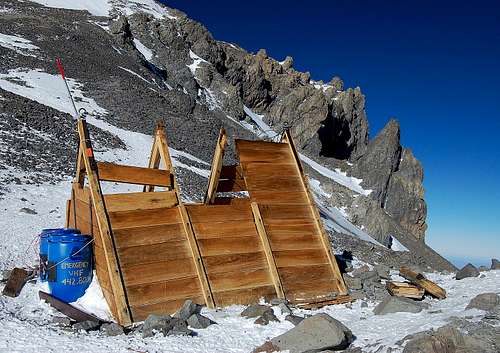
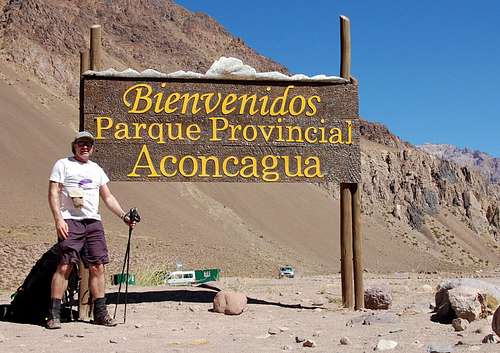
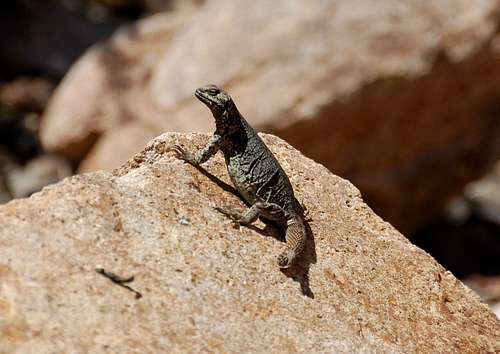

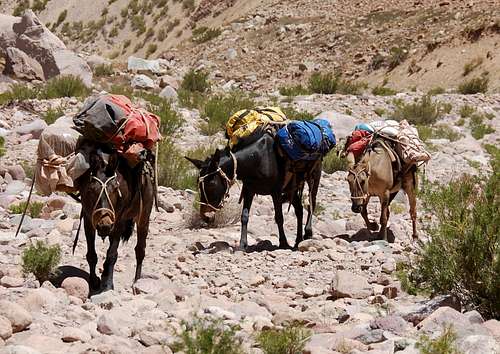
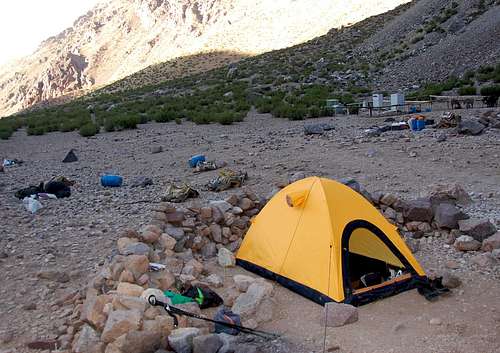
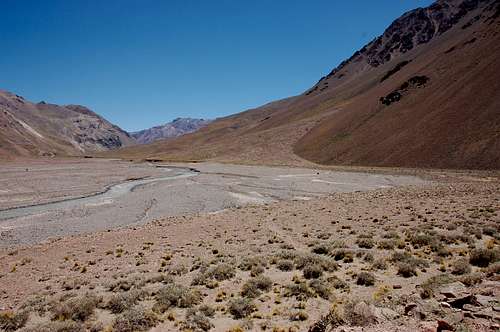
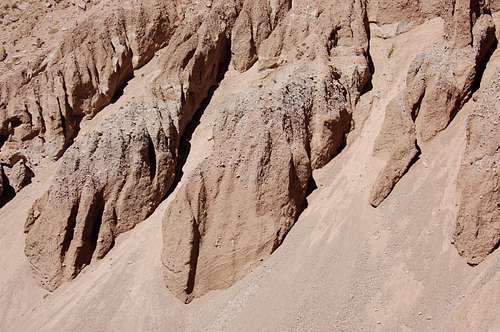

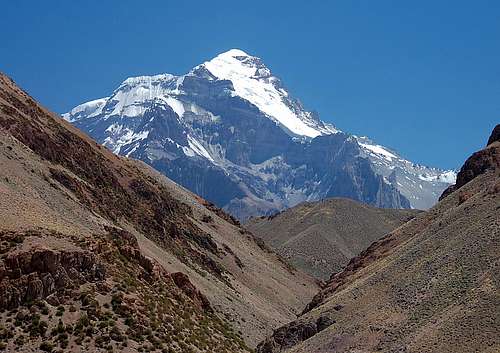
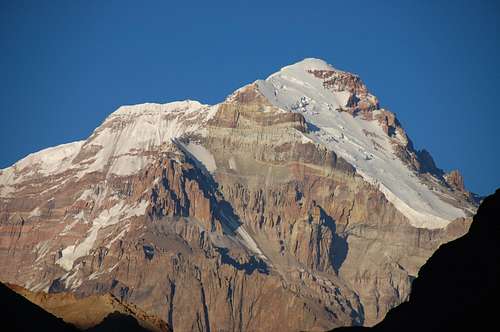
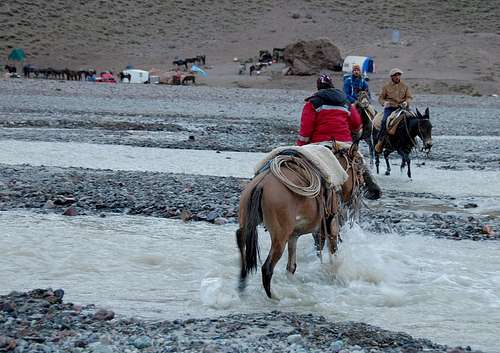

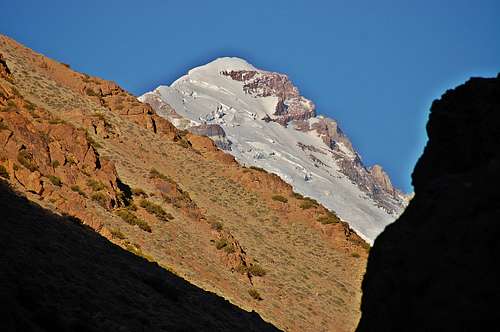
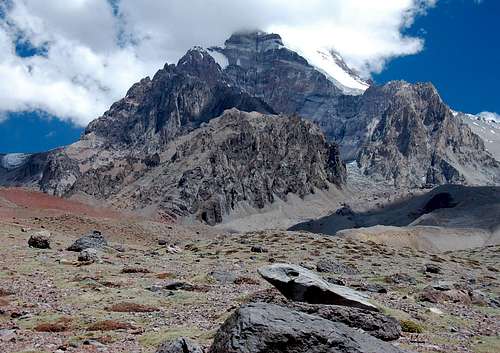
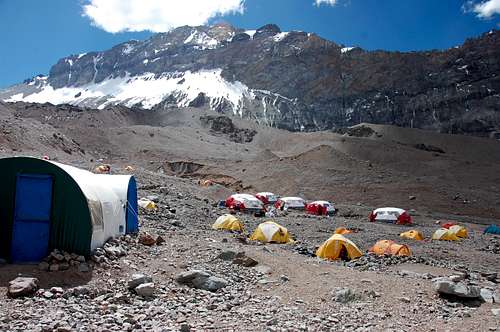
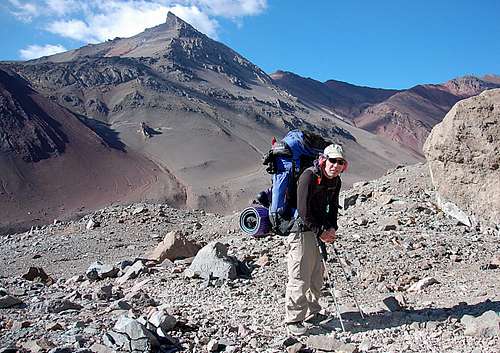
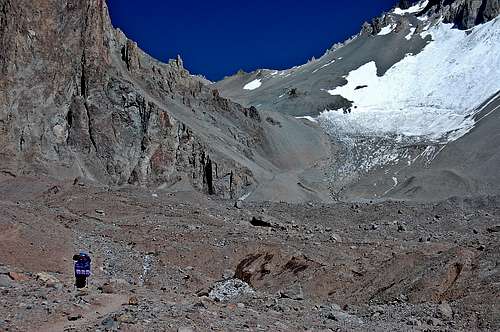

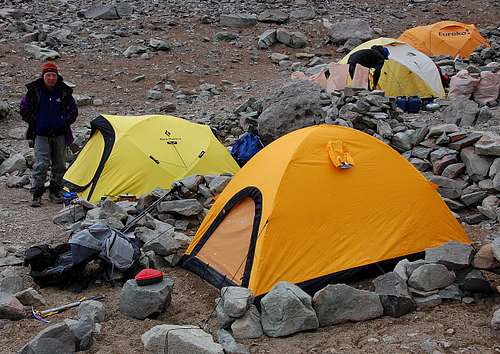
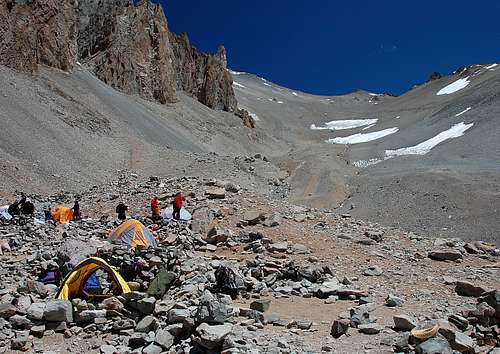
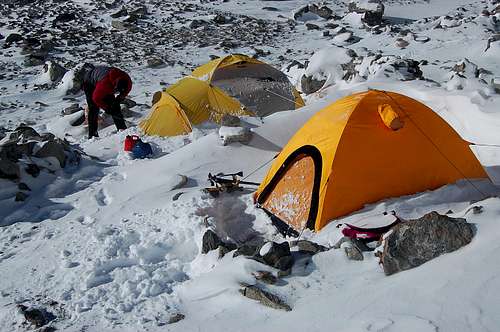
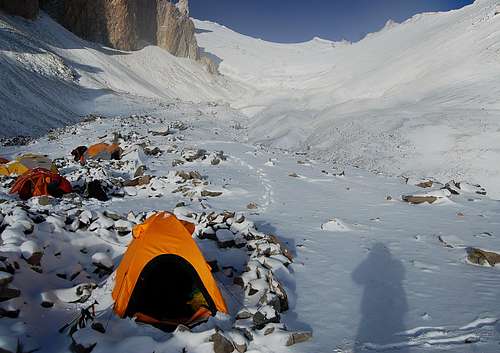
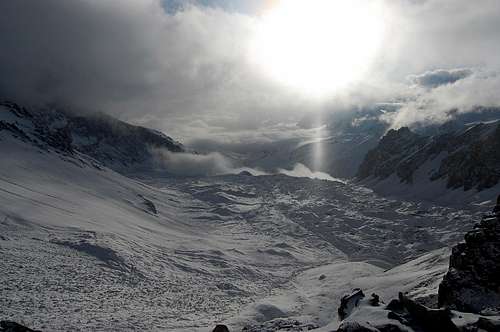
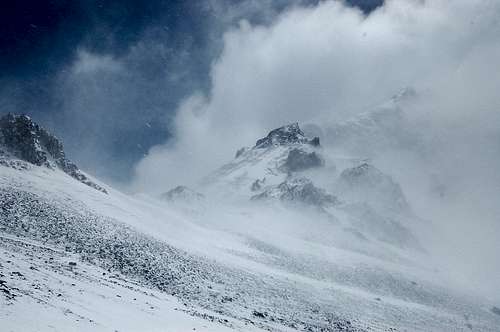
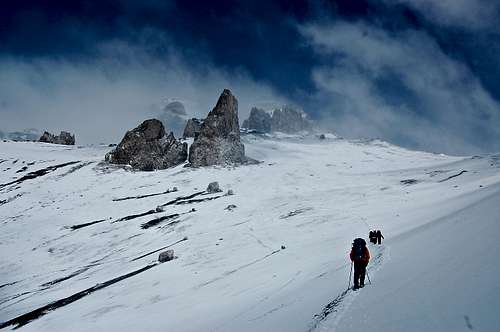
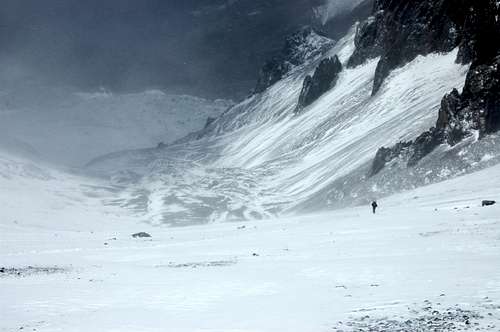
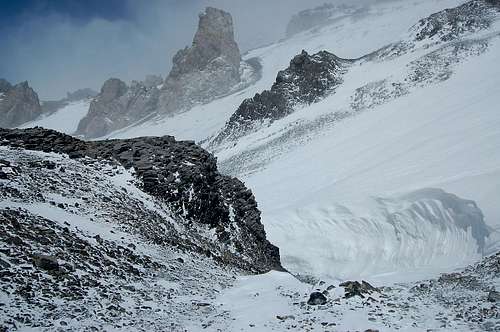
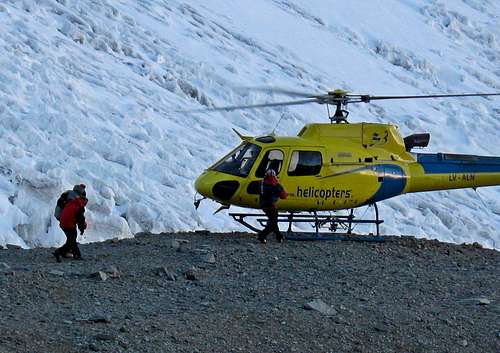
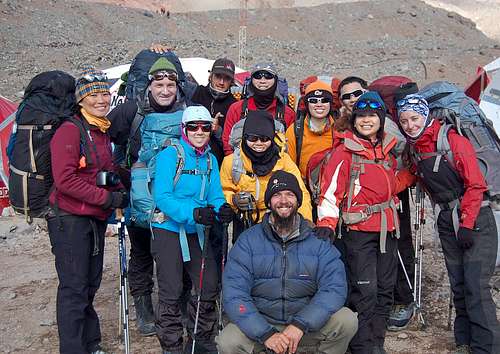
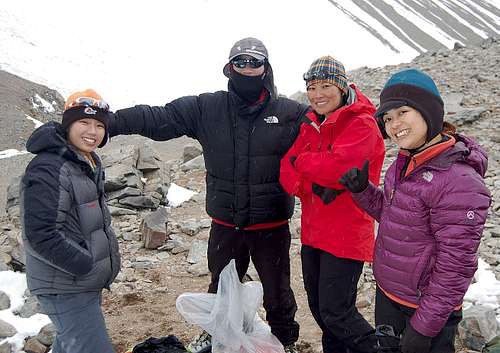

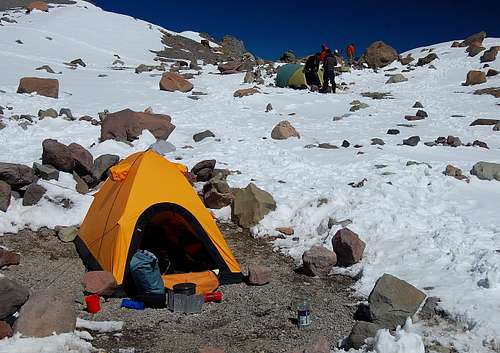

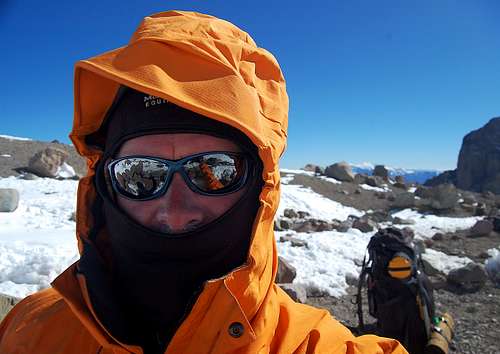
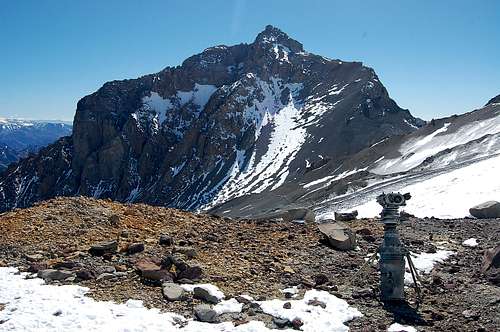
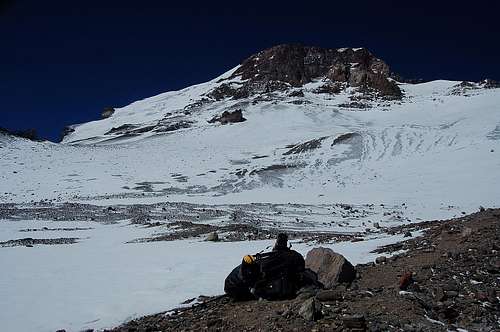
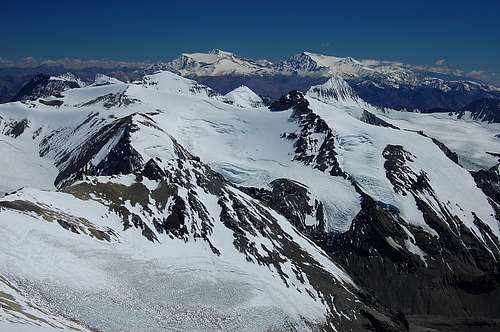
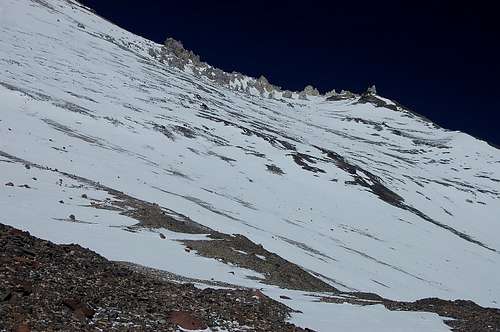
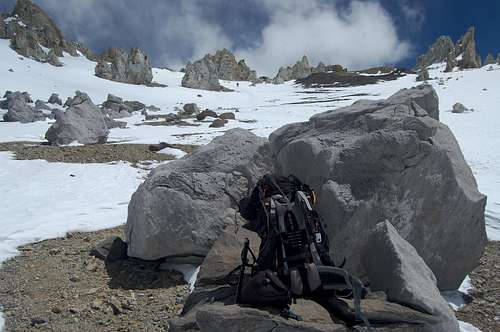
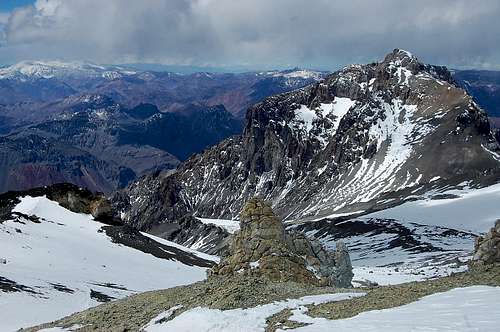

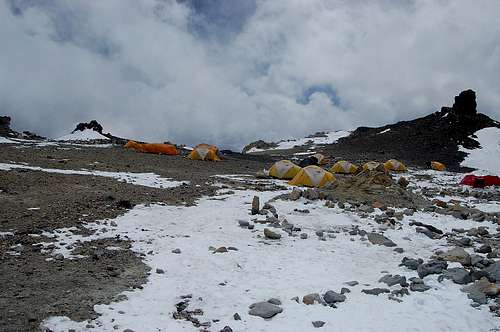
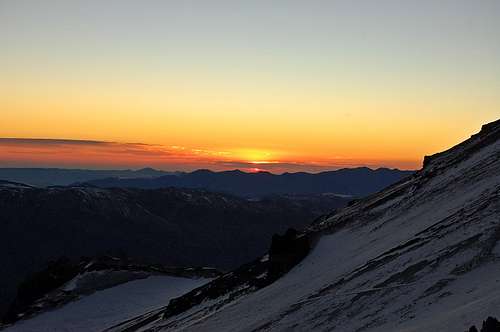
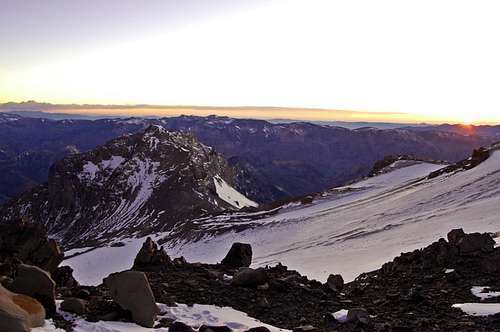
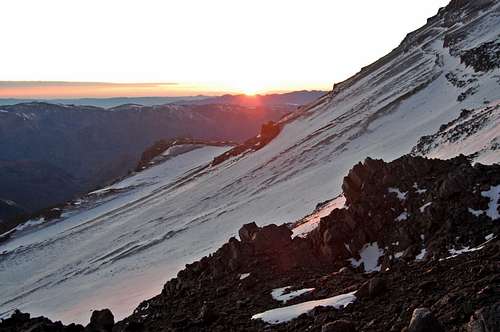
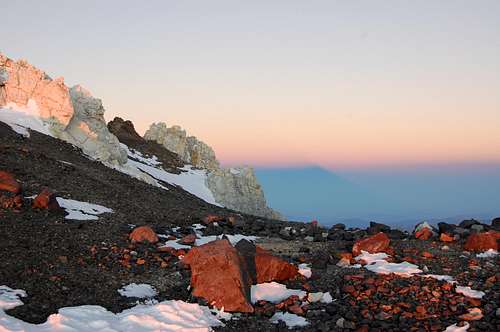
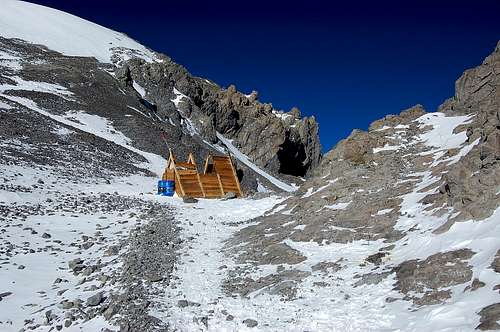
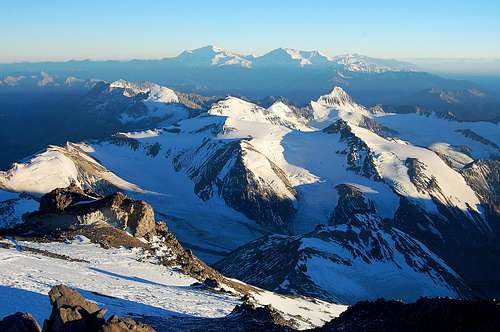
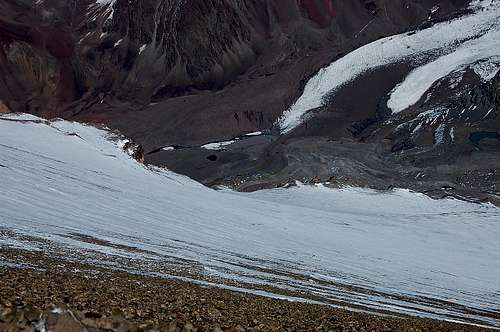
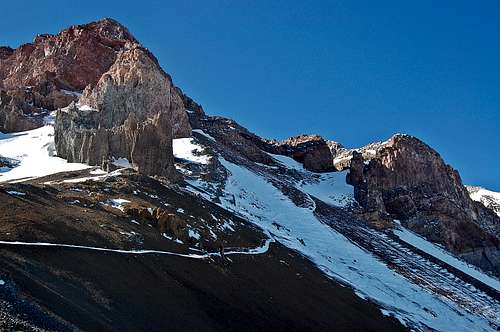
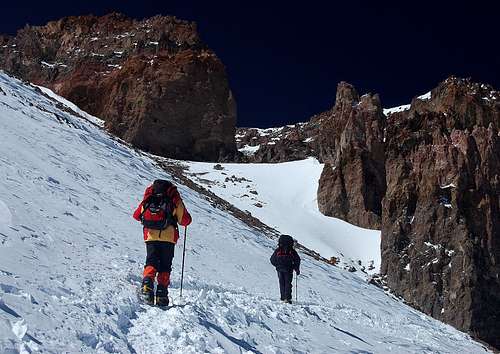
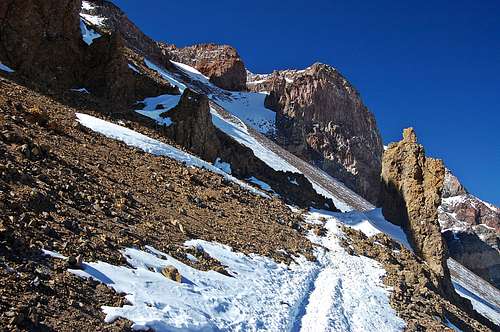
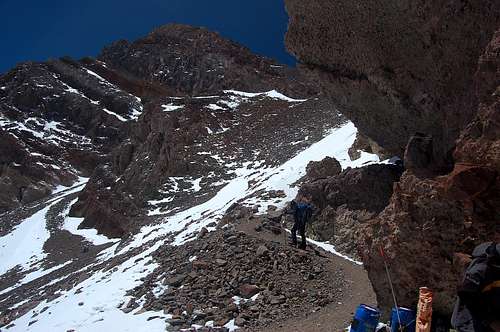

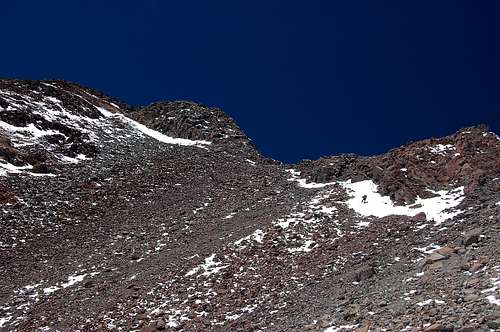

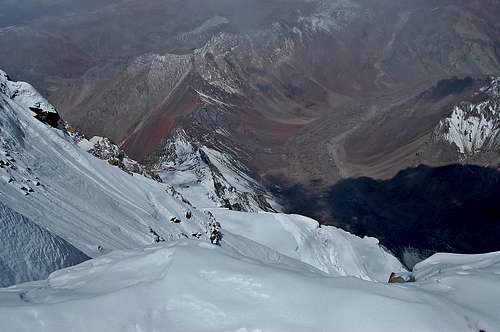
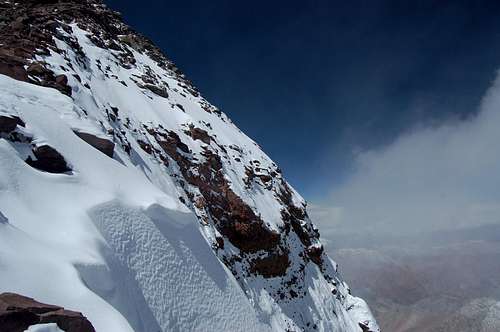
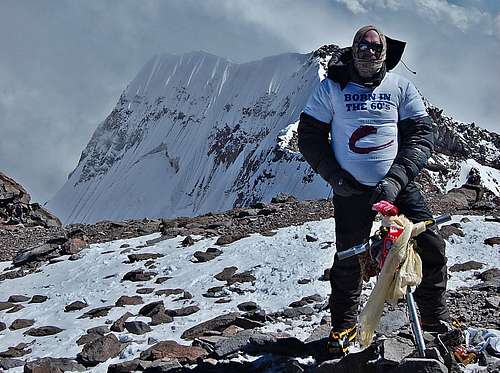
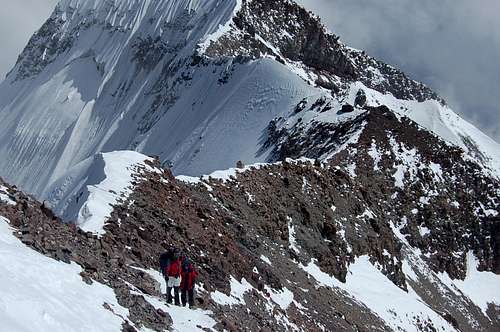
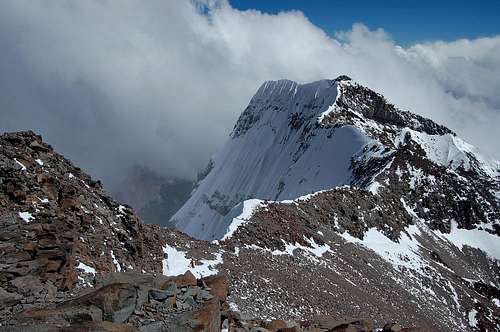
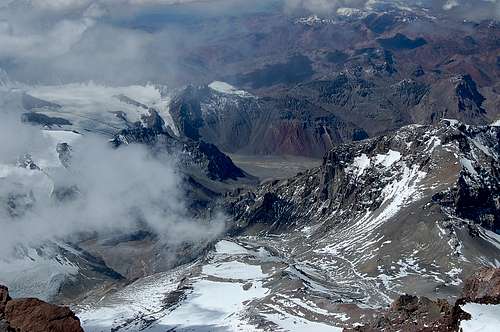
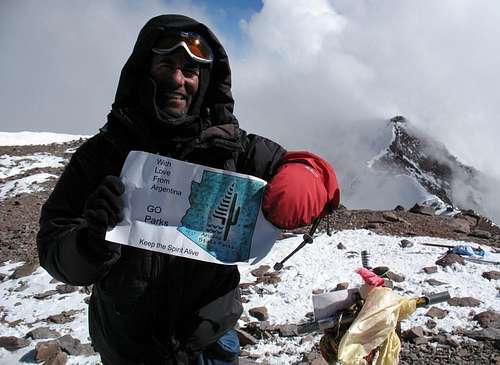
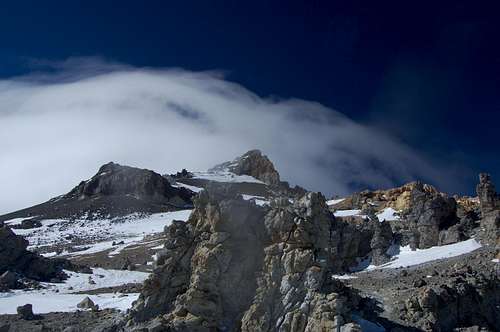
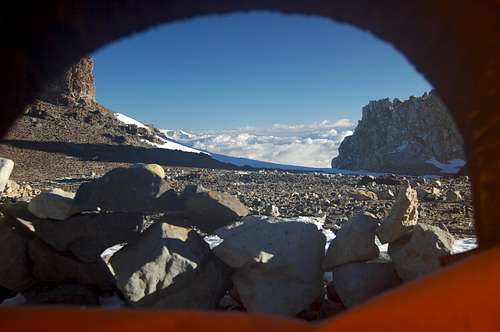
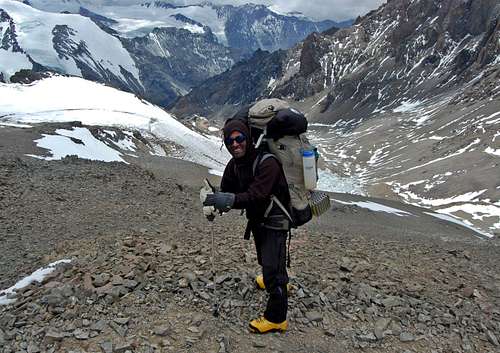
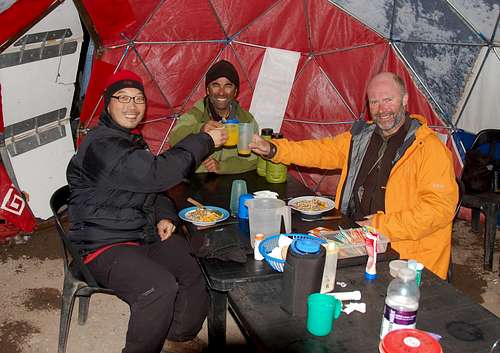
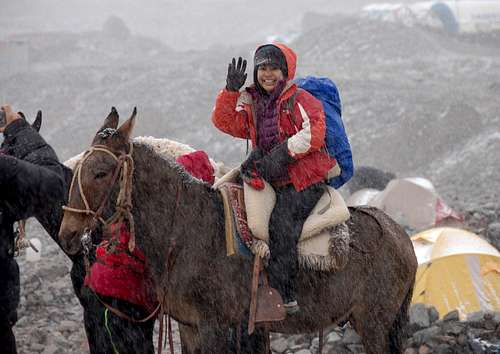
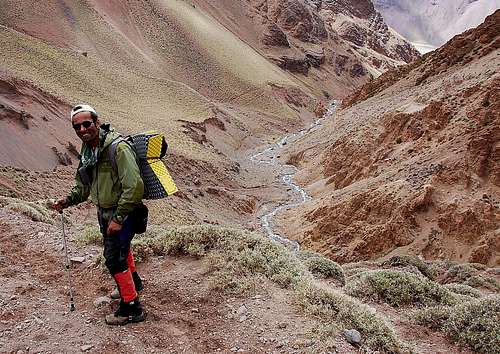


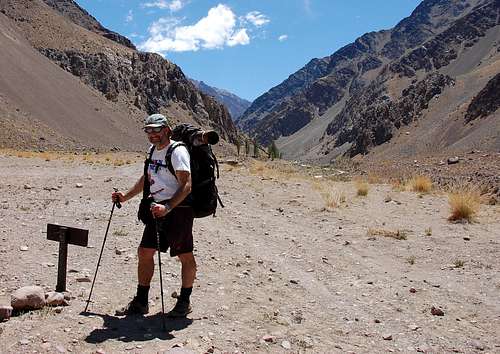
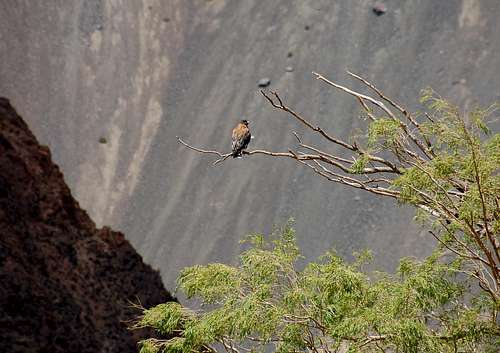
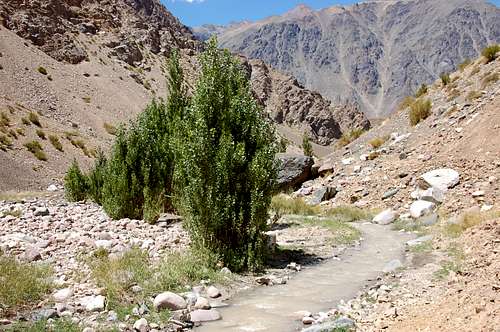
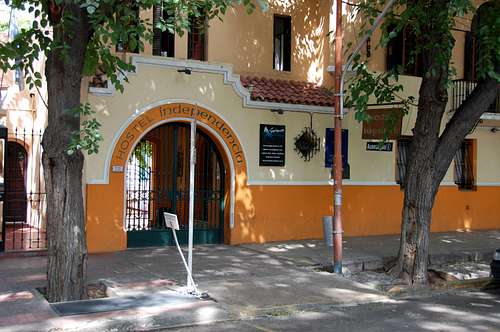










Comments
Post a Comment